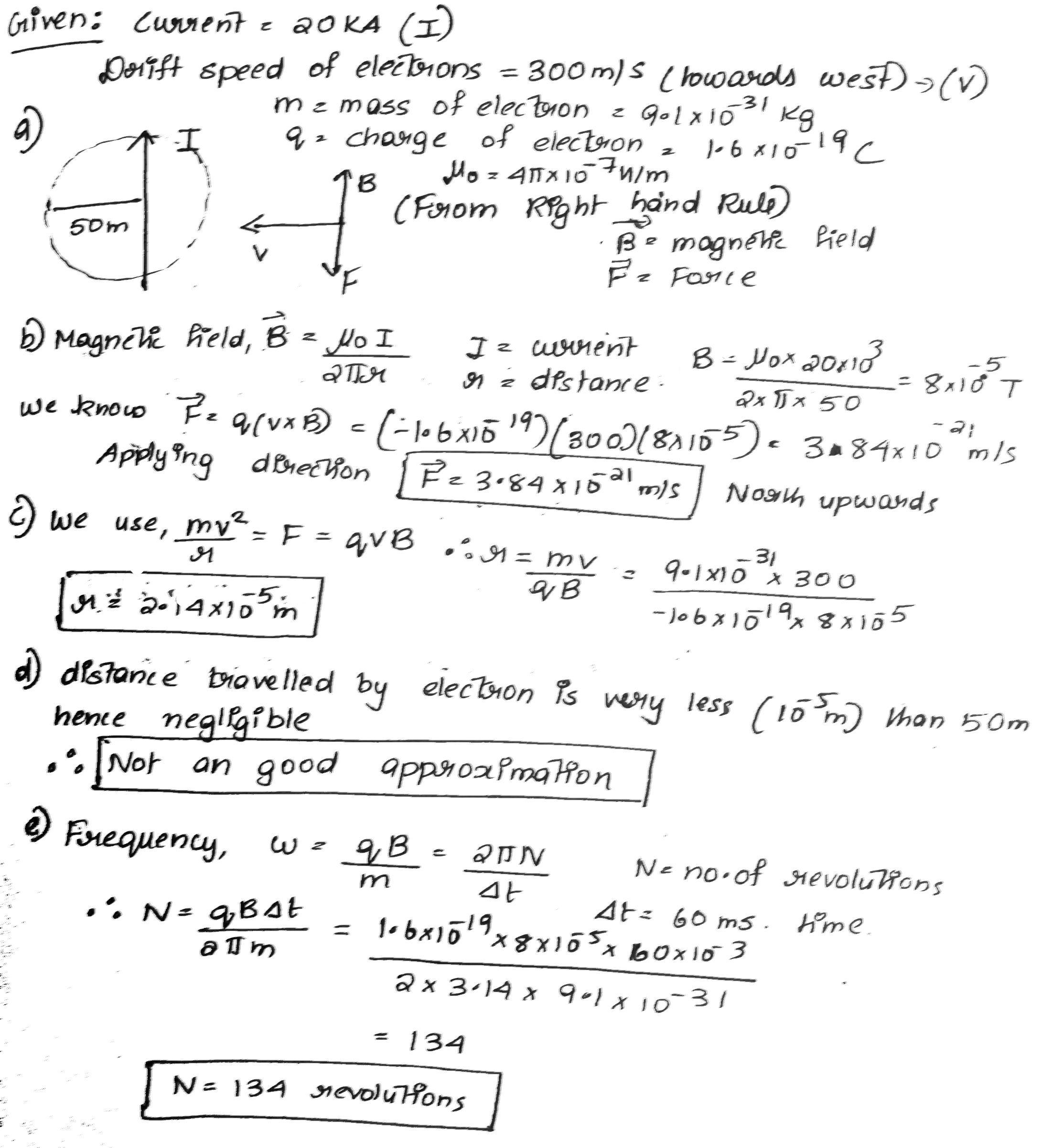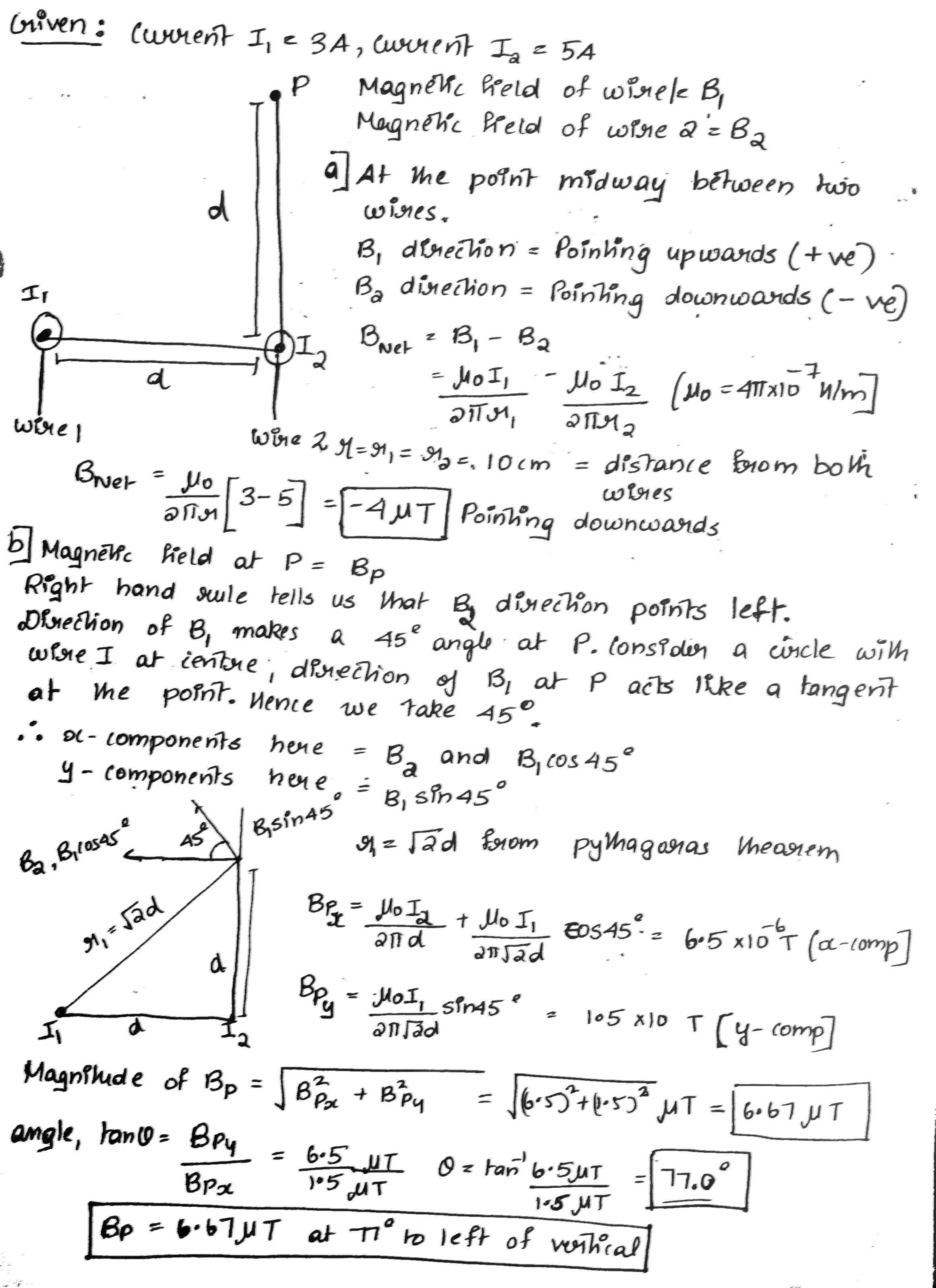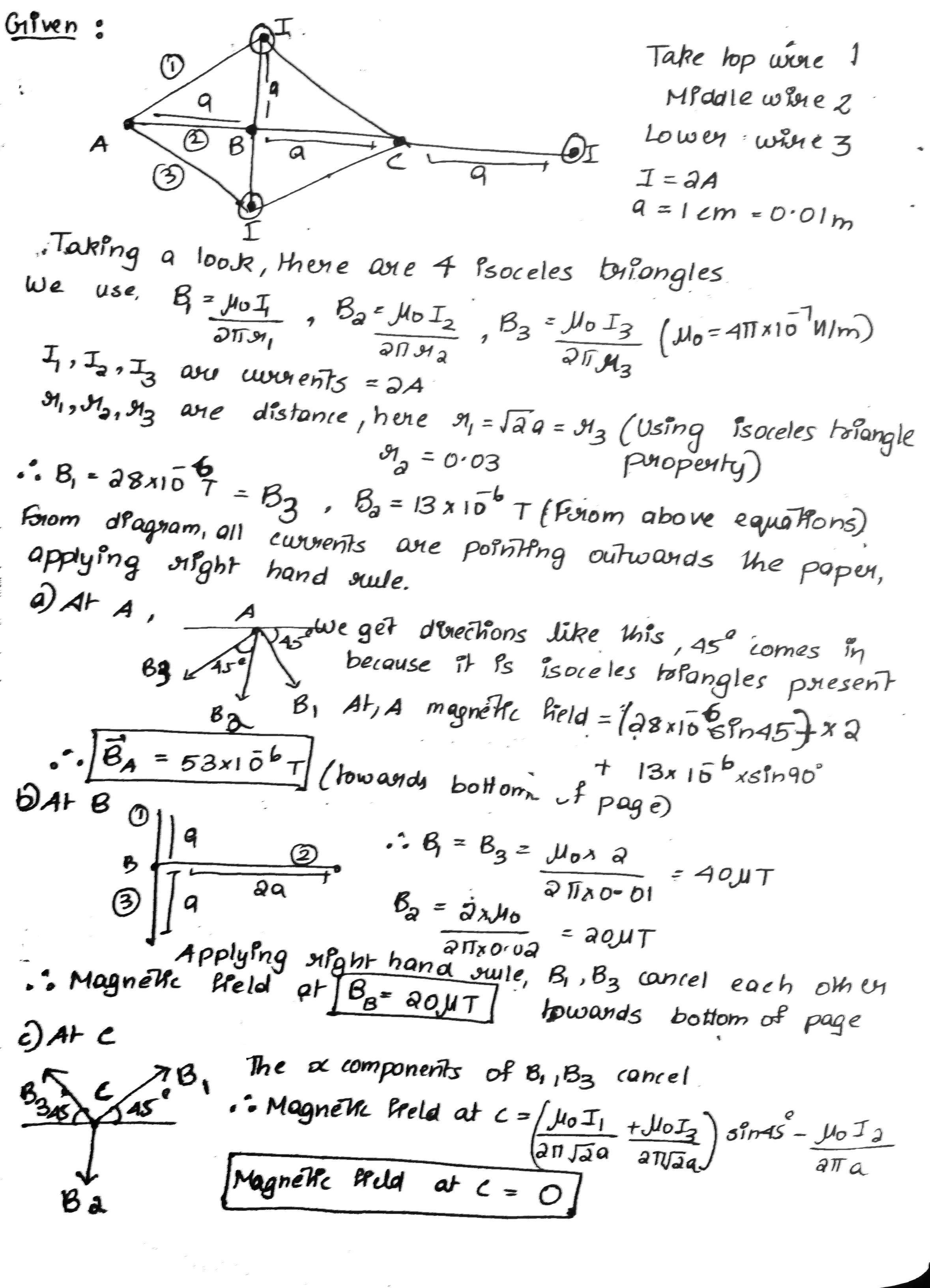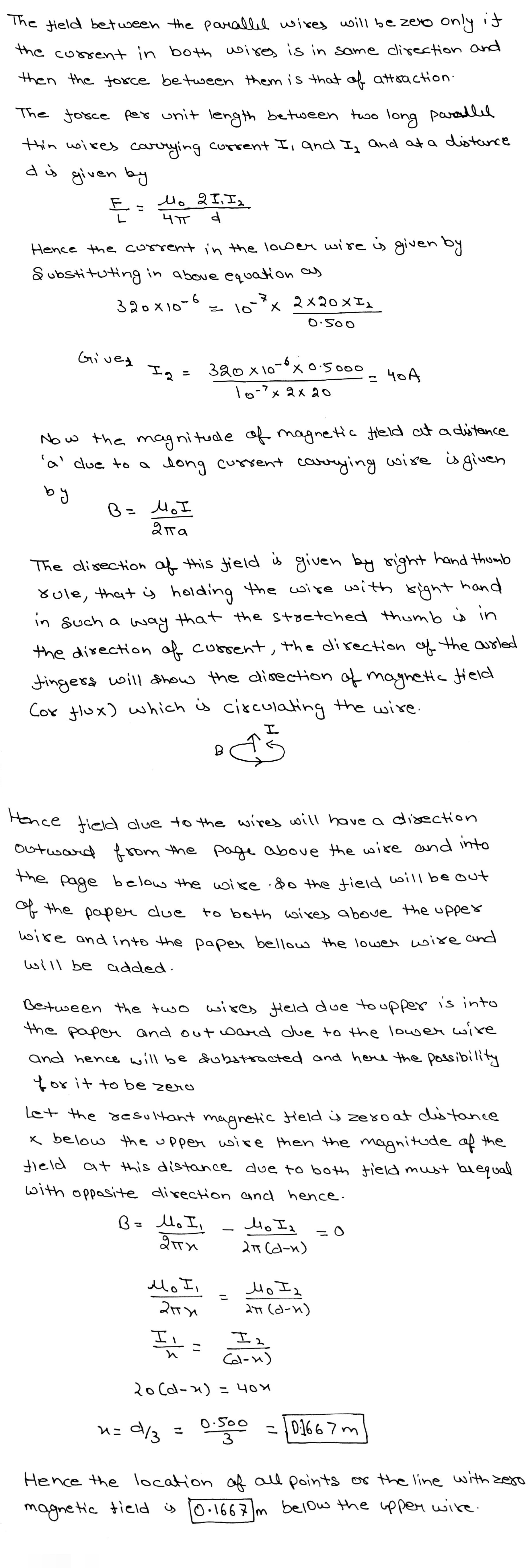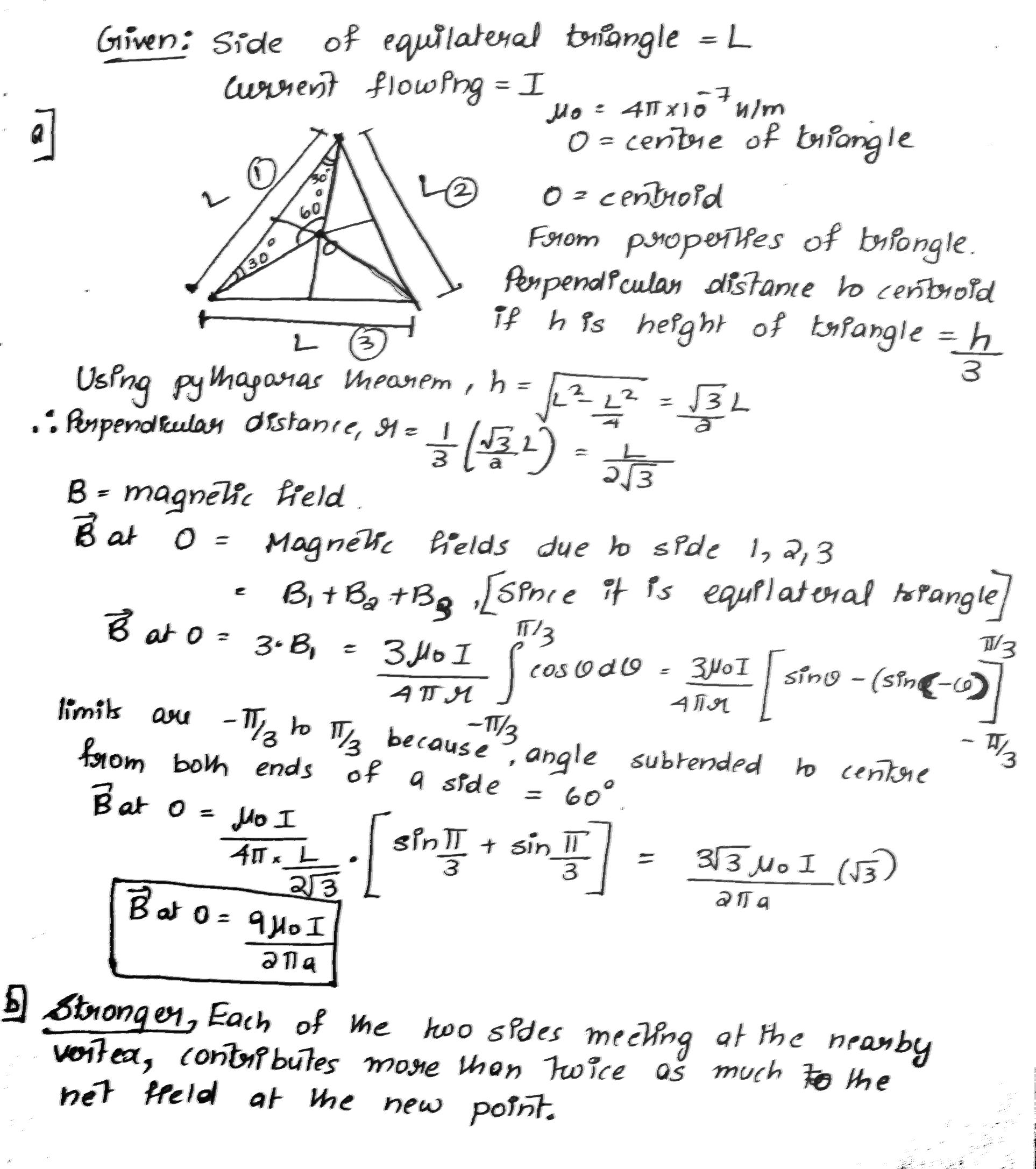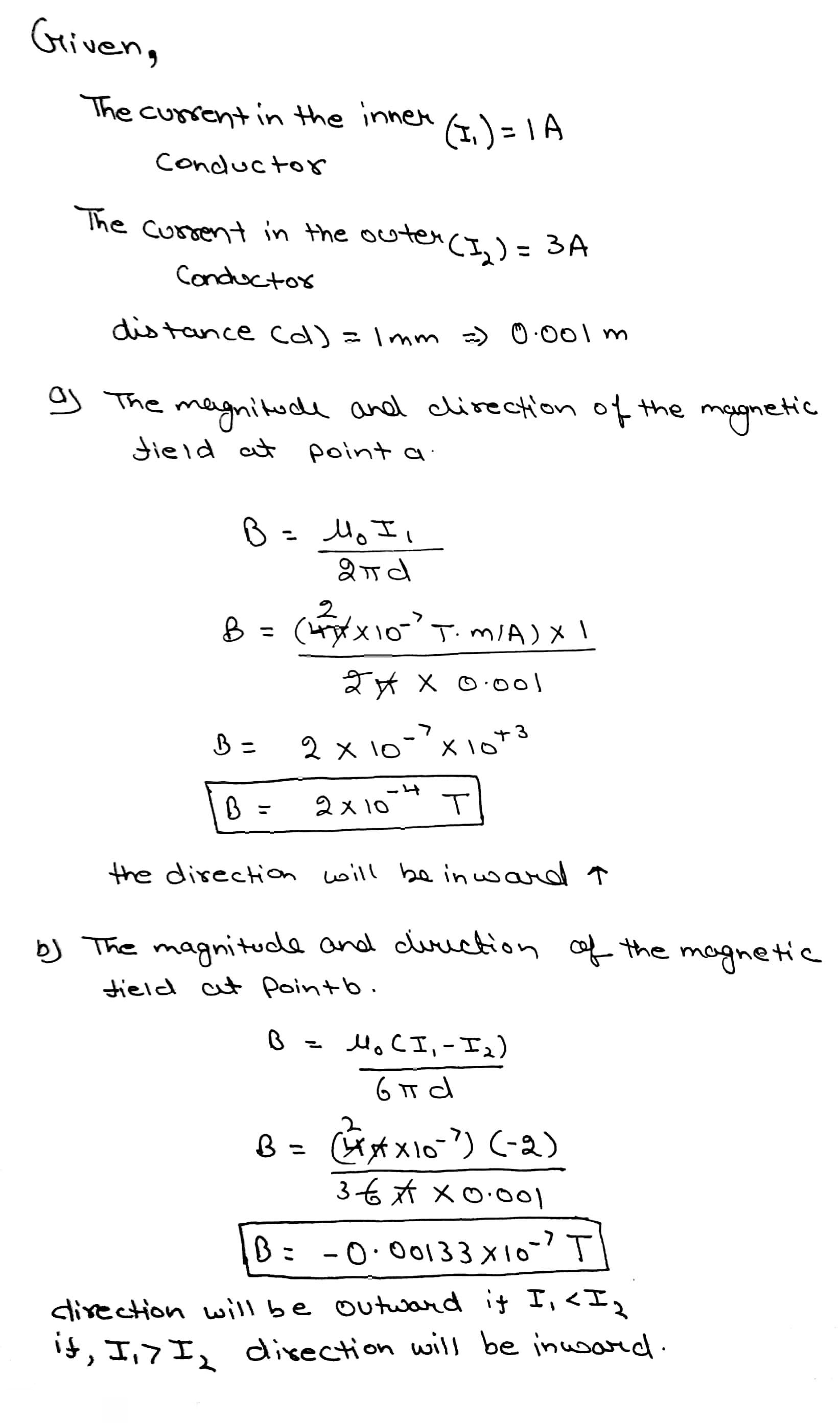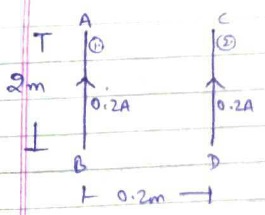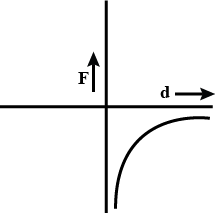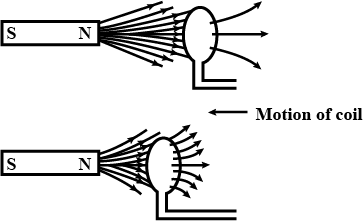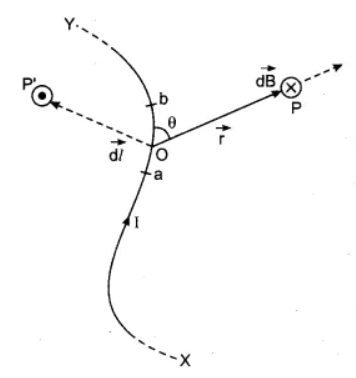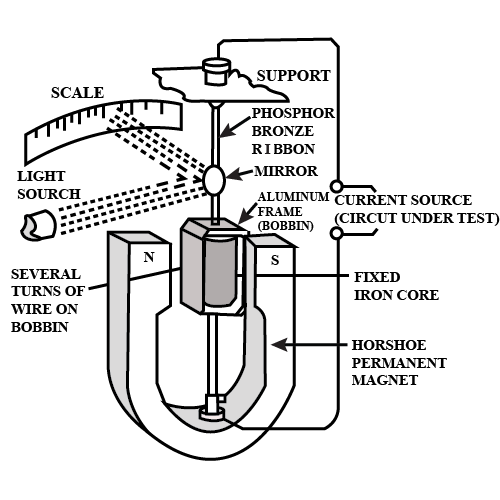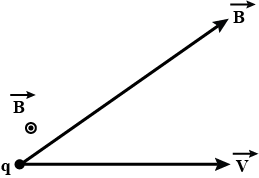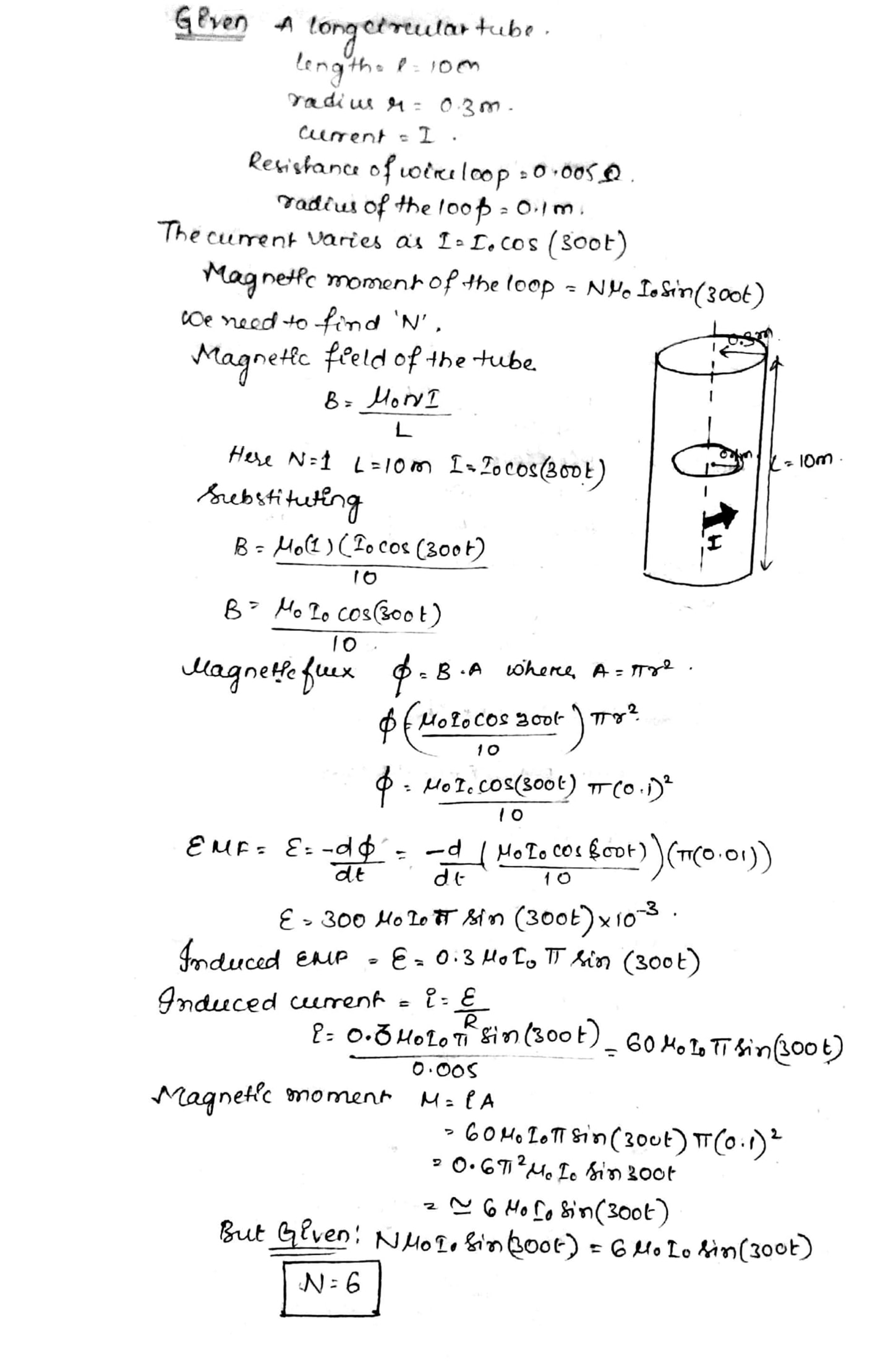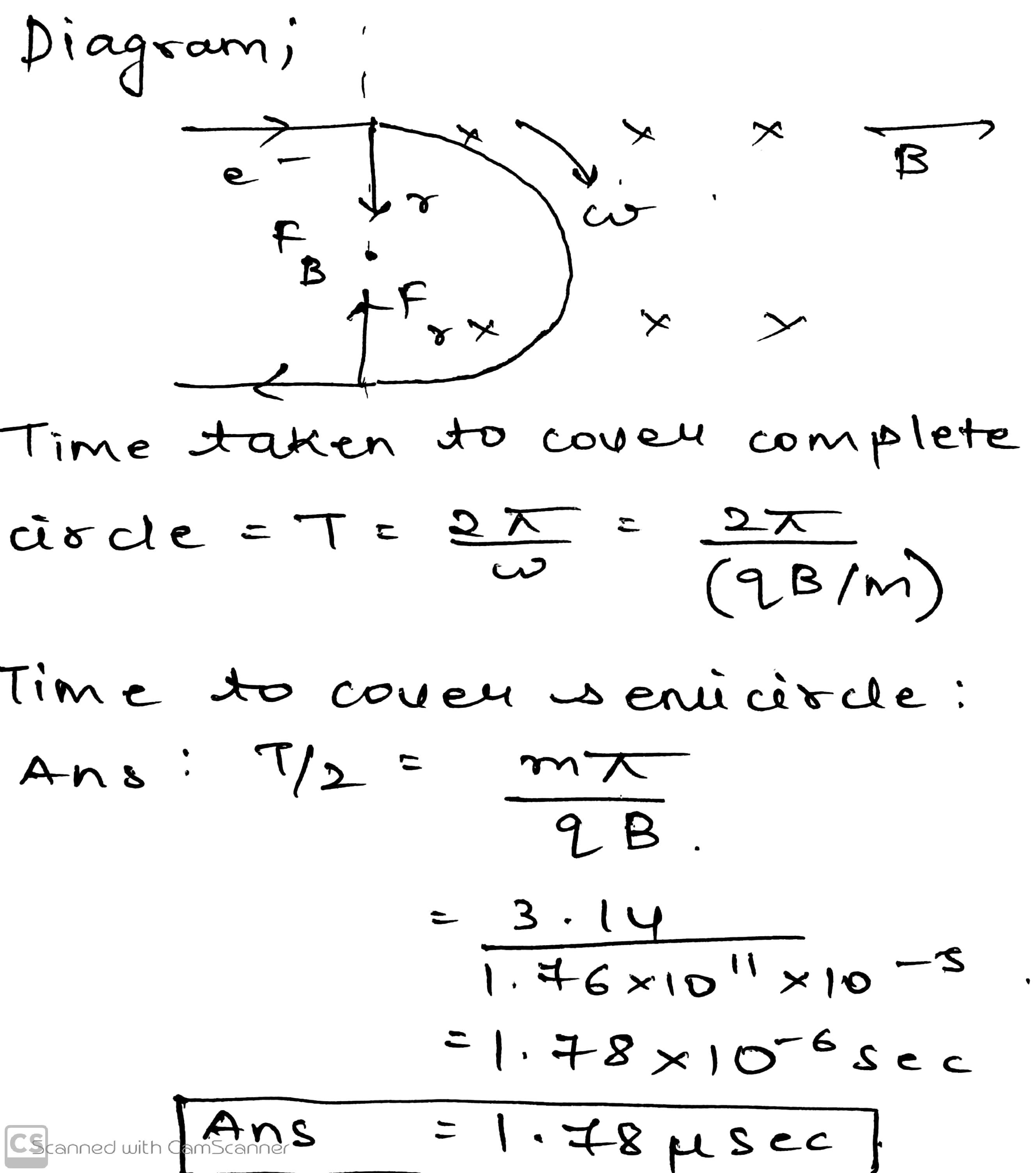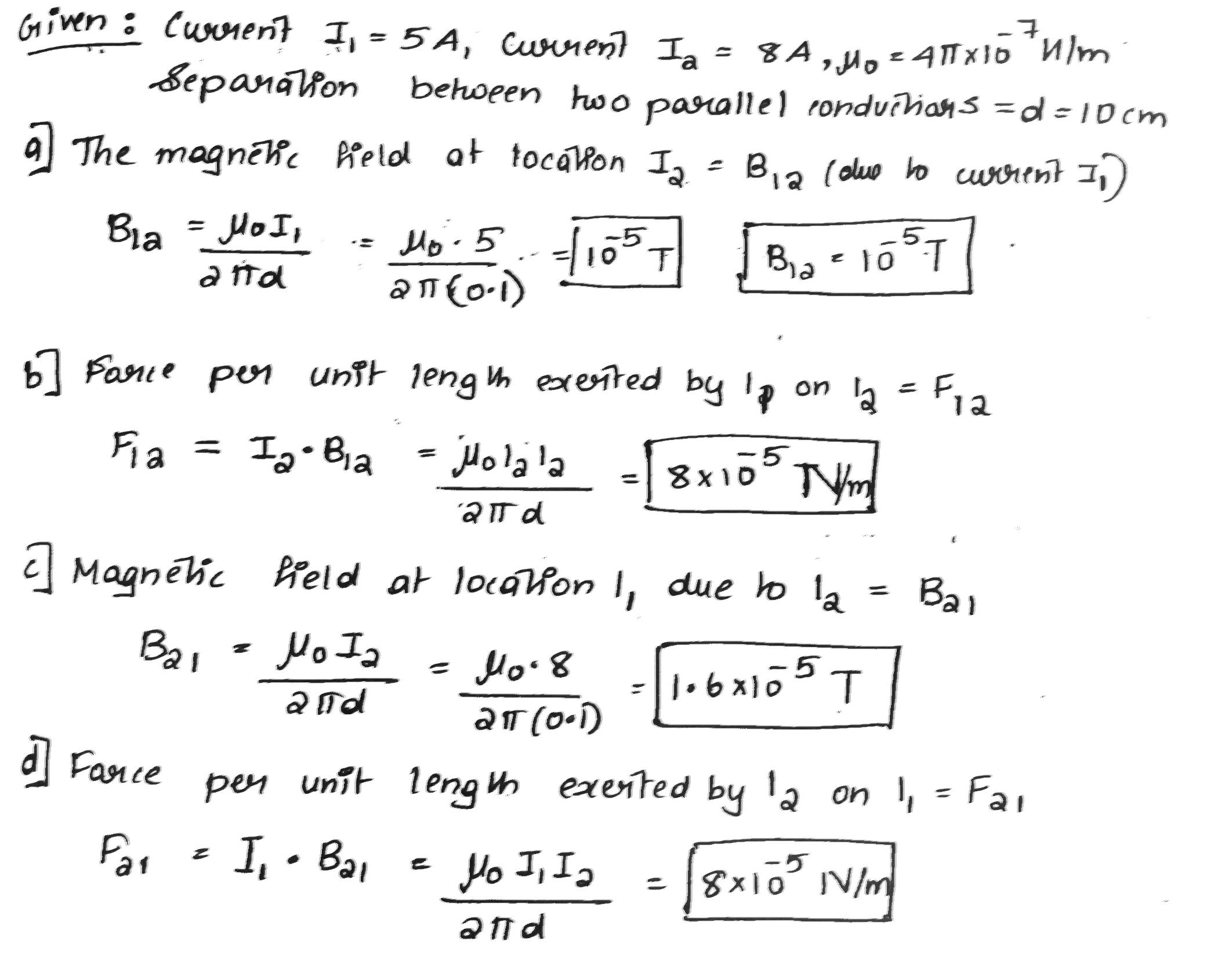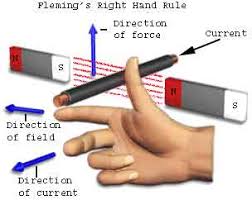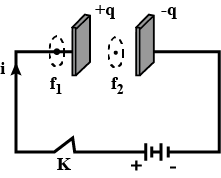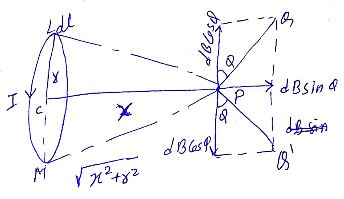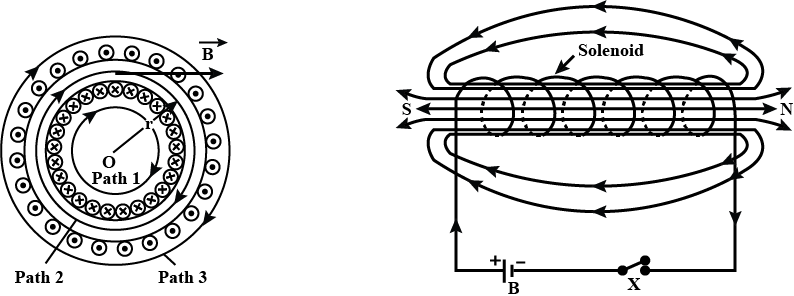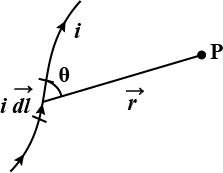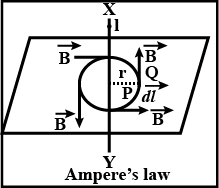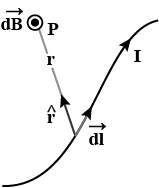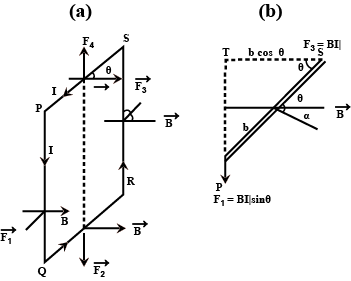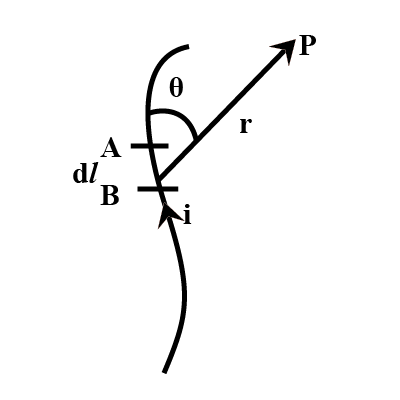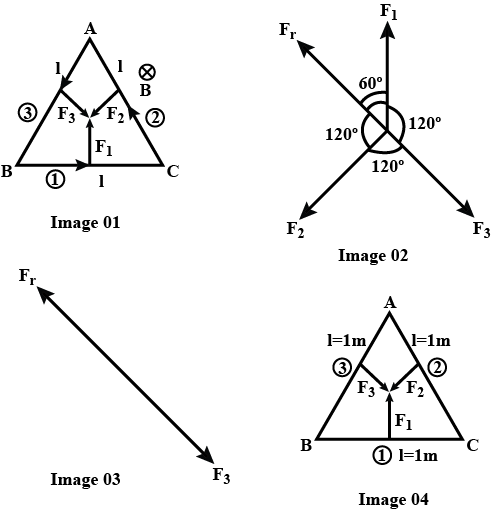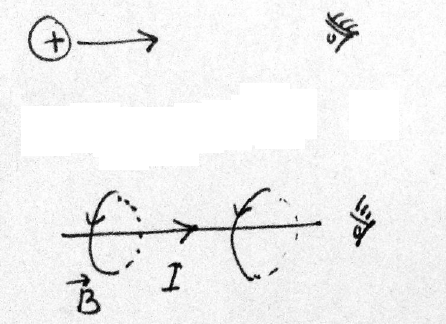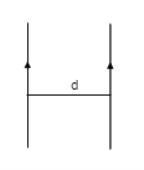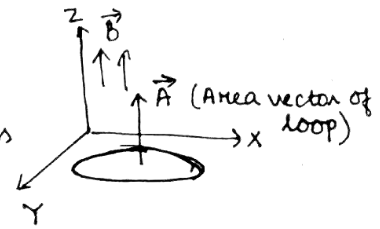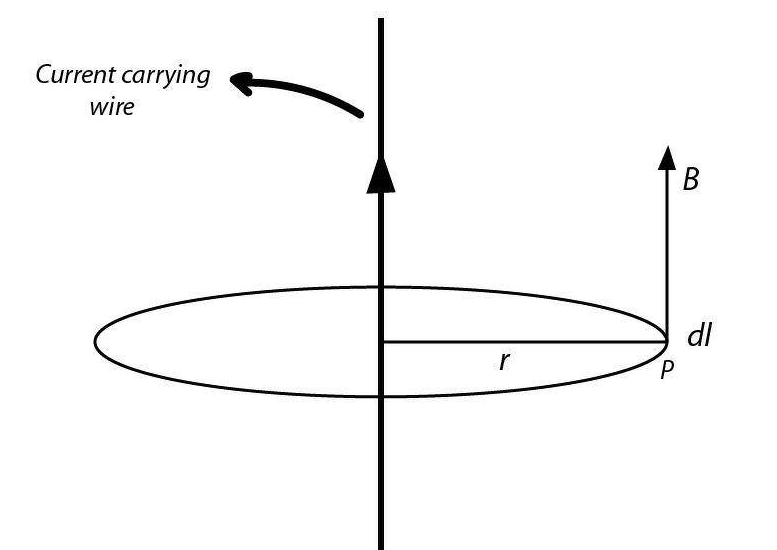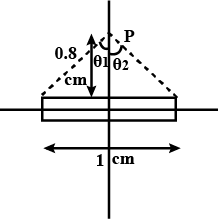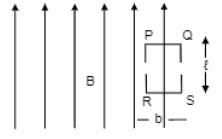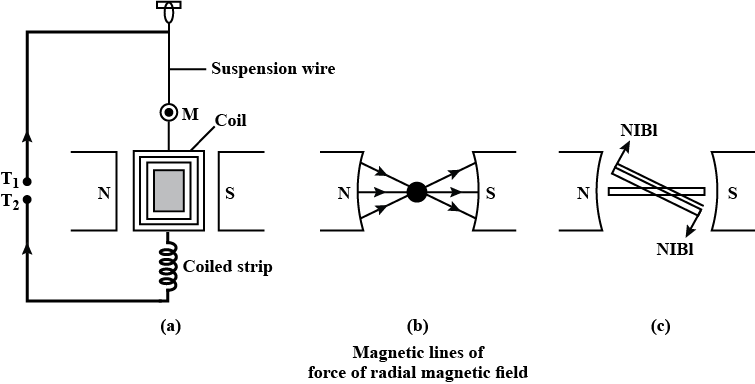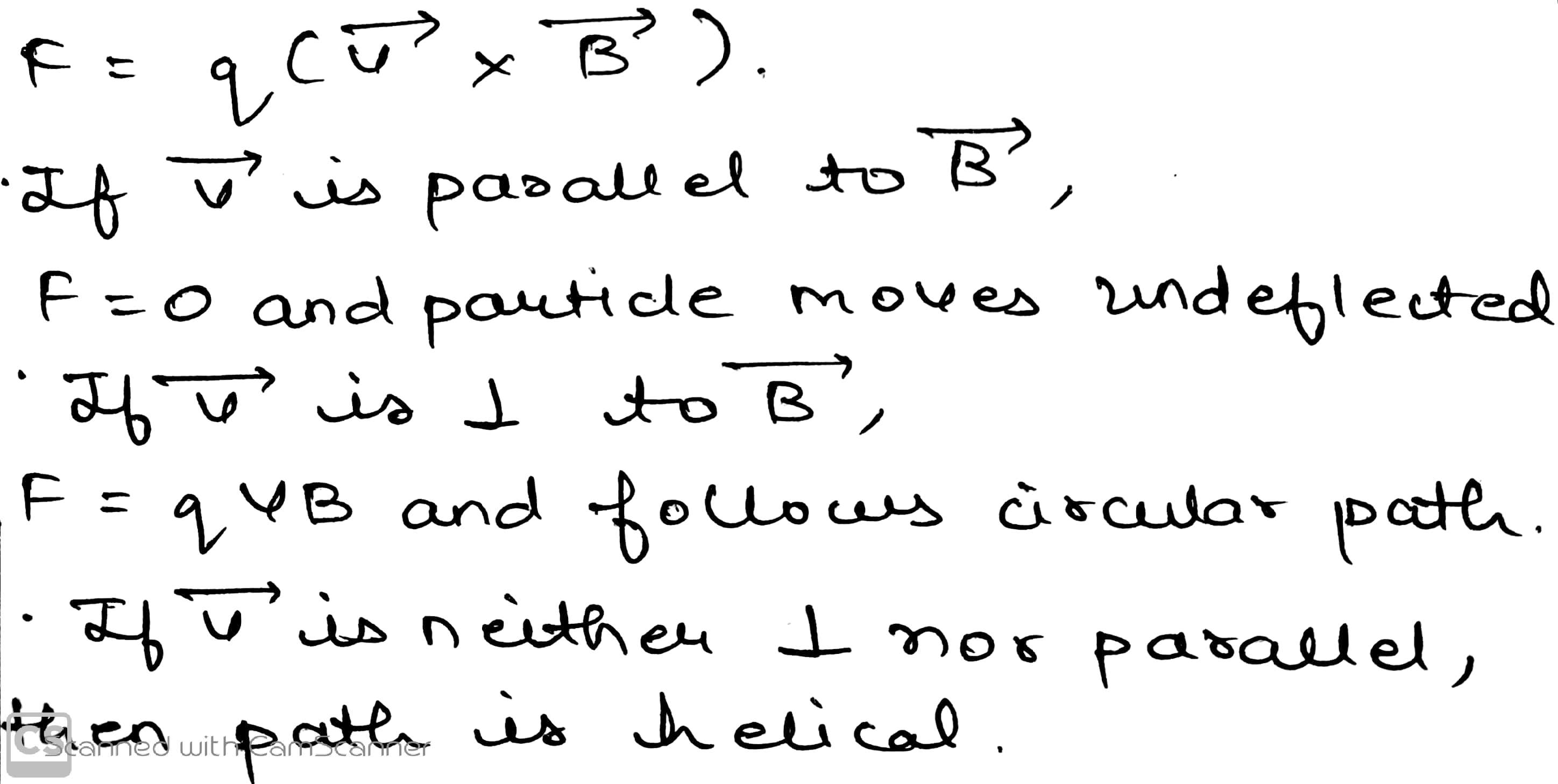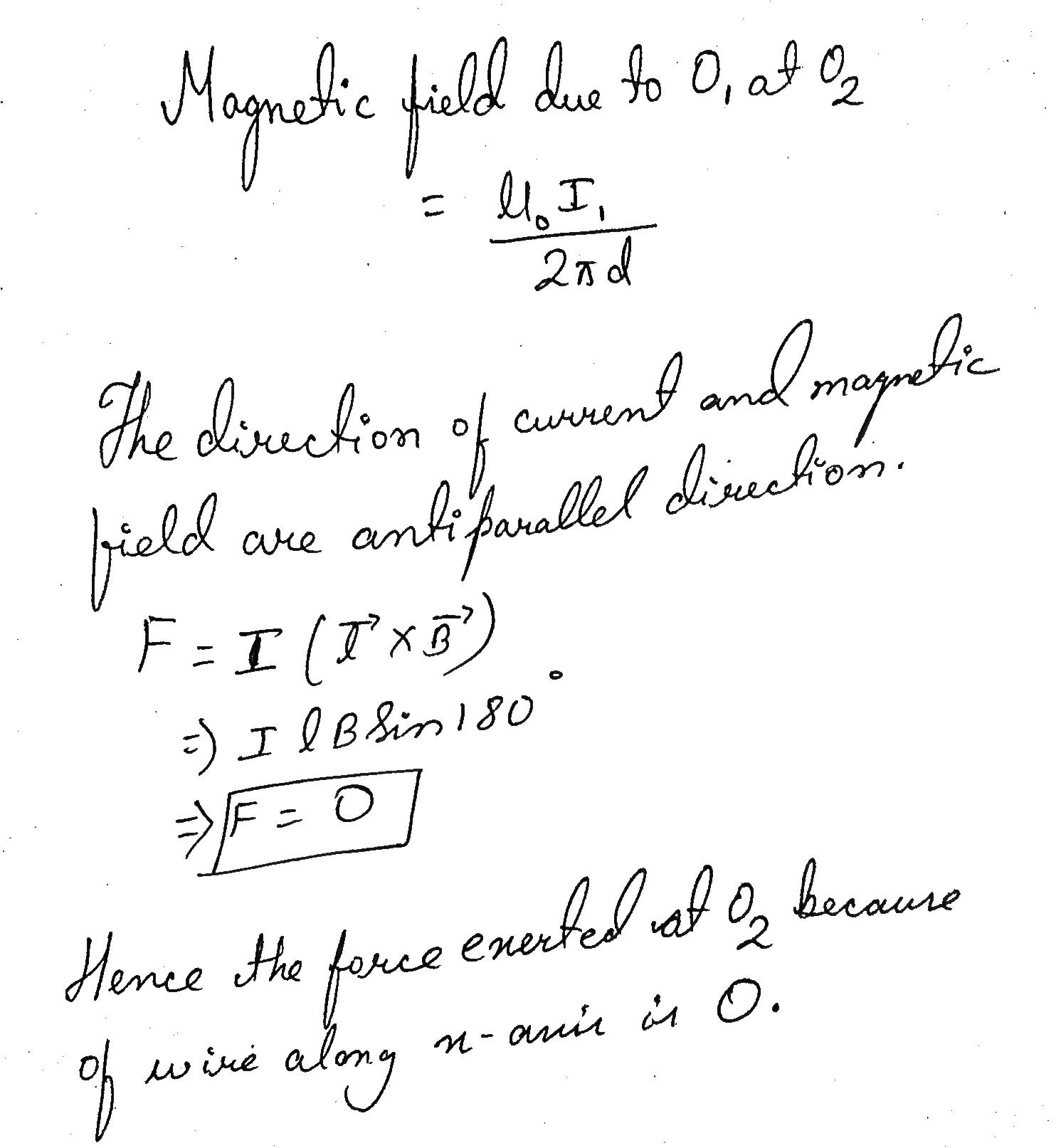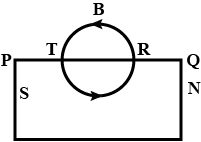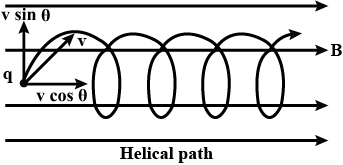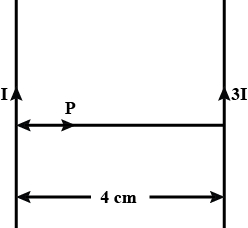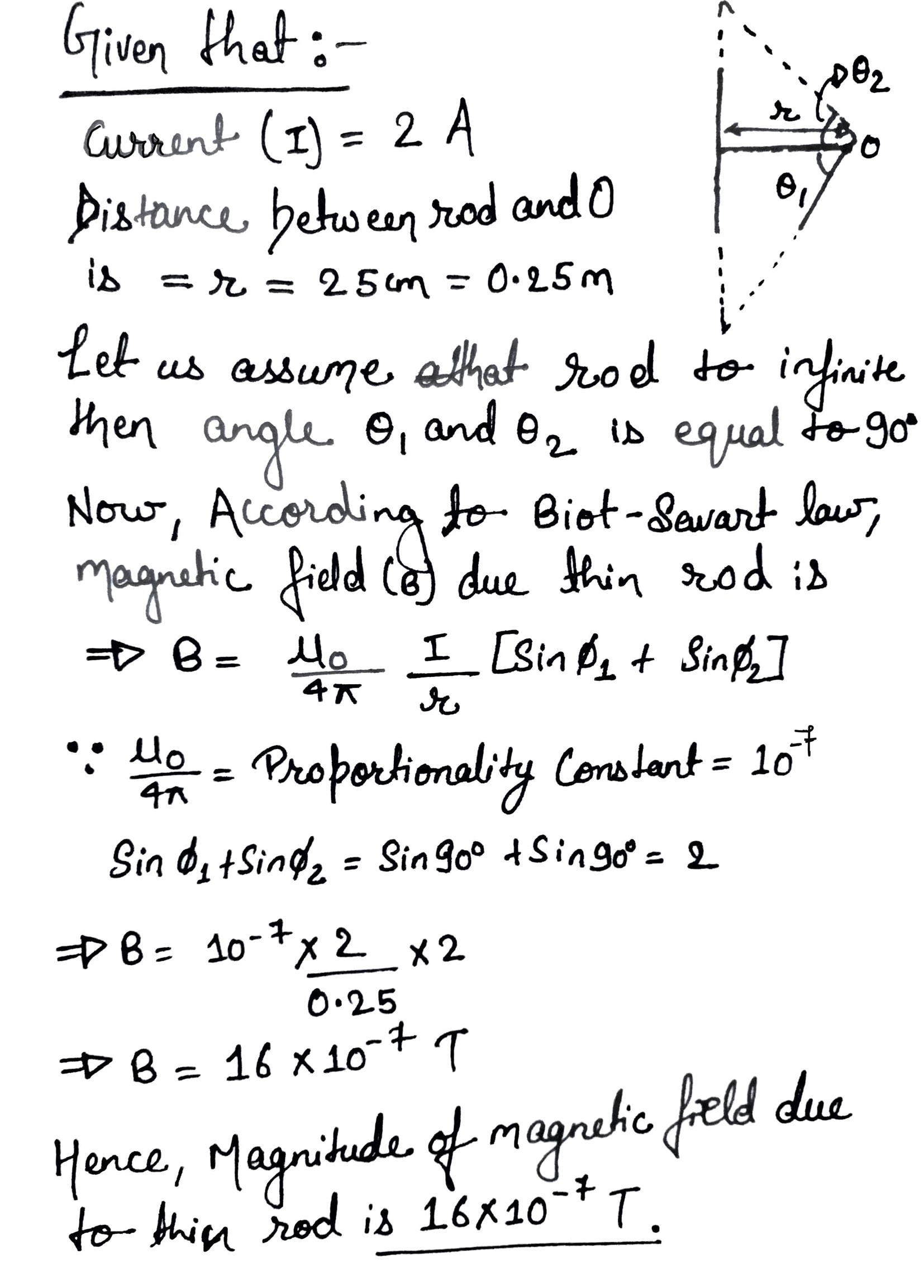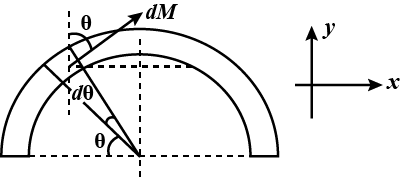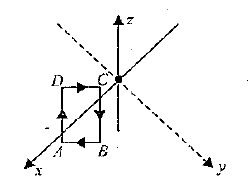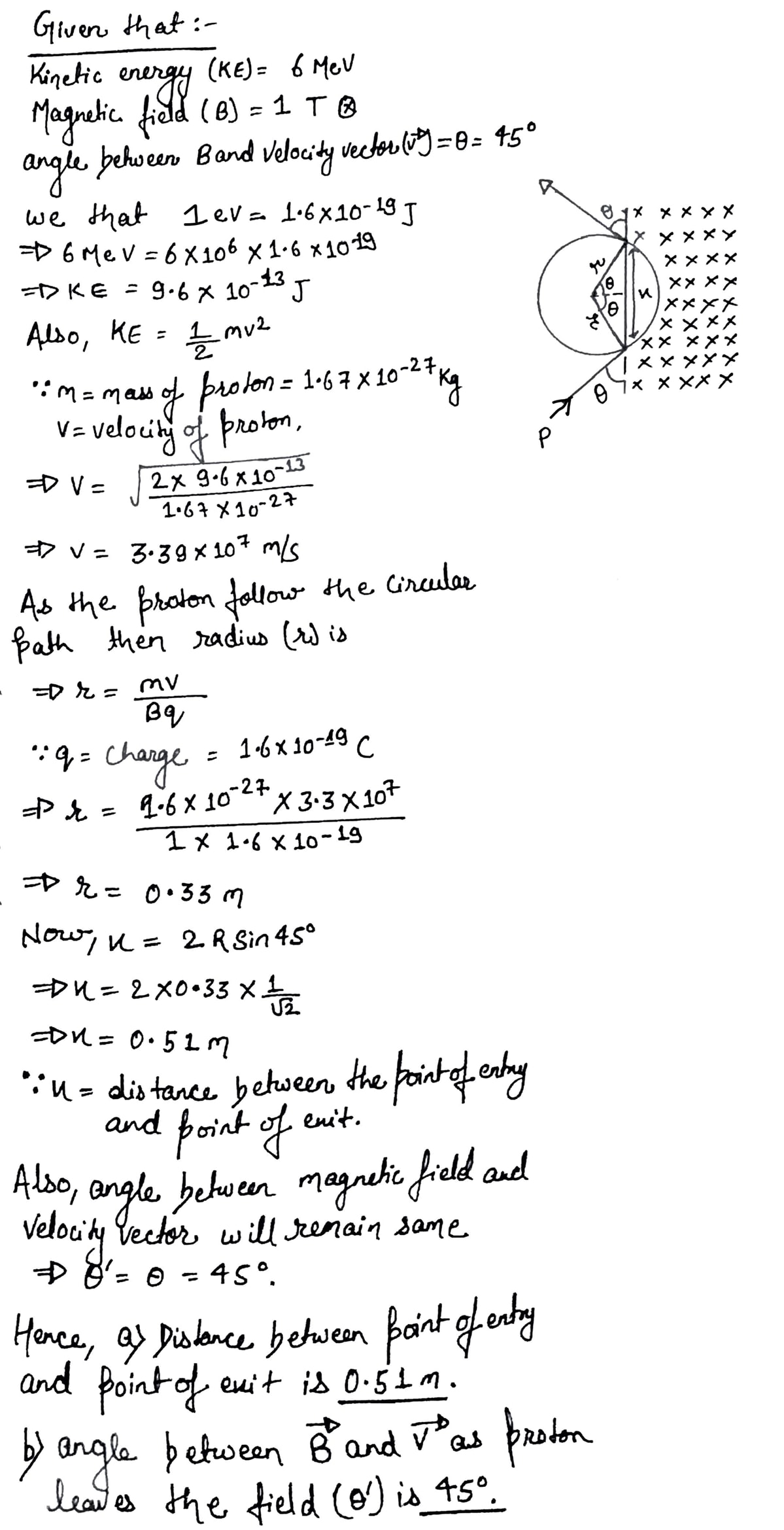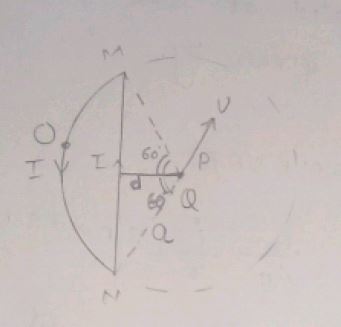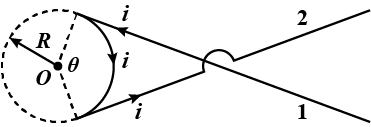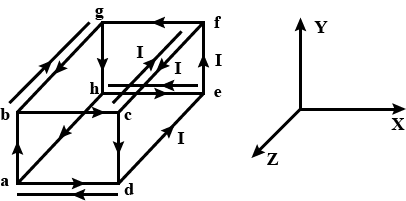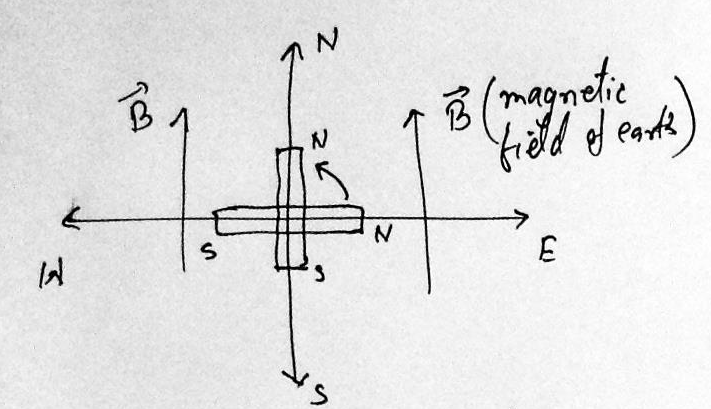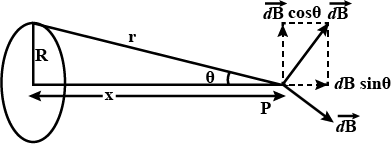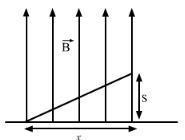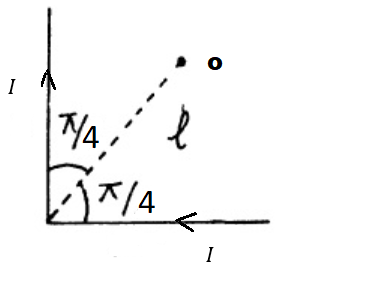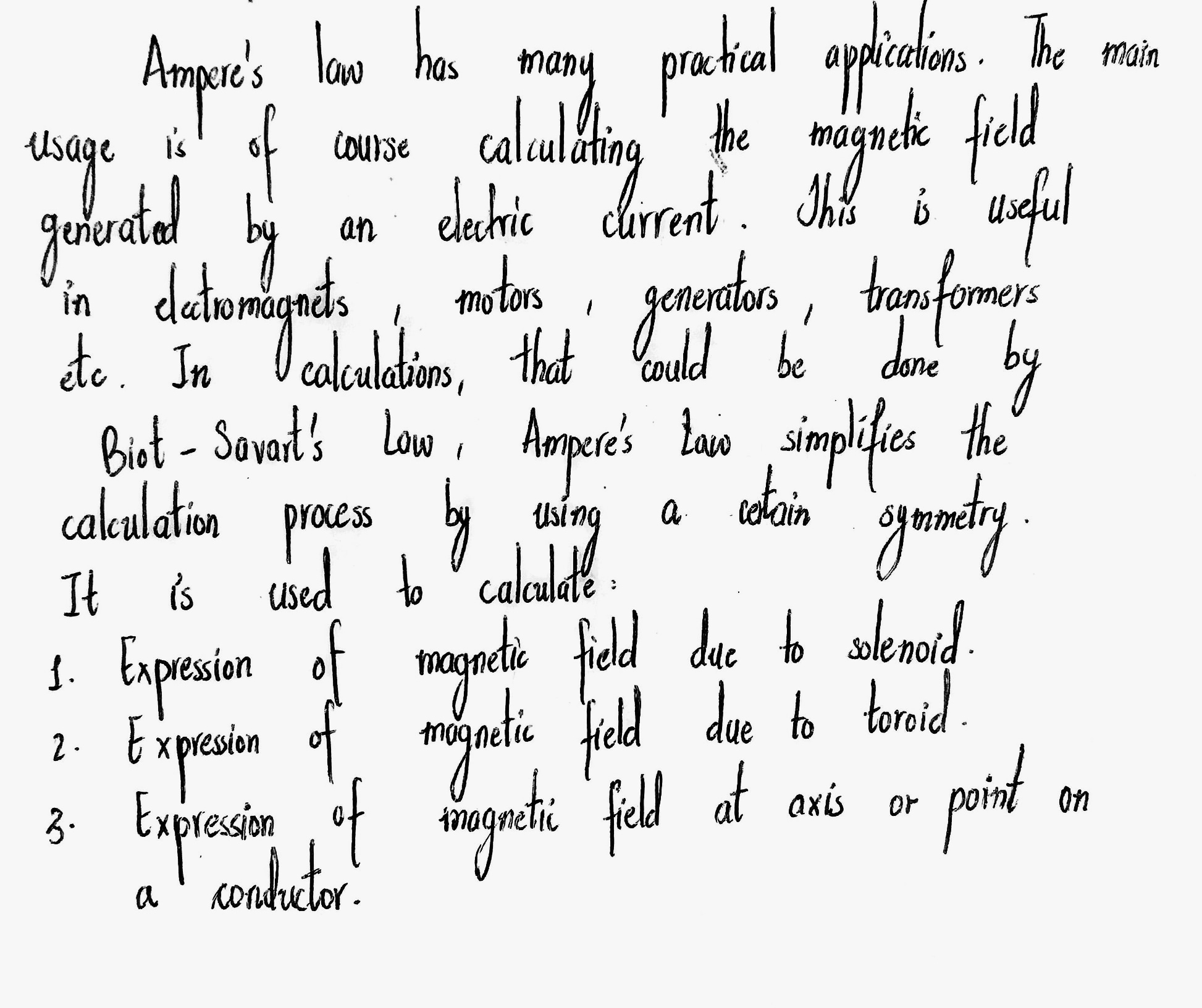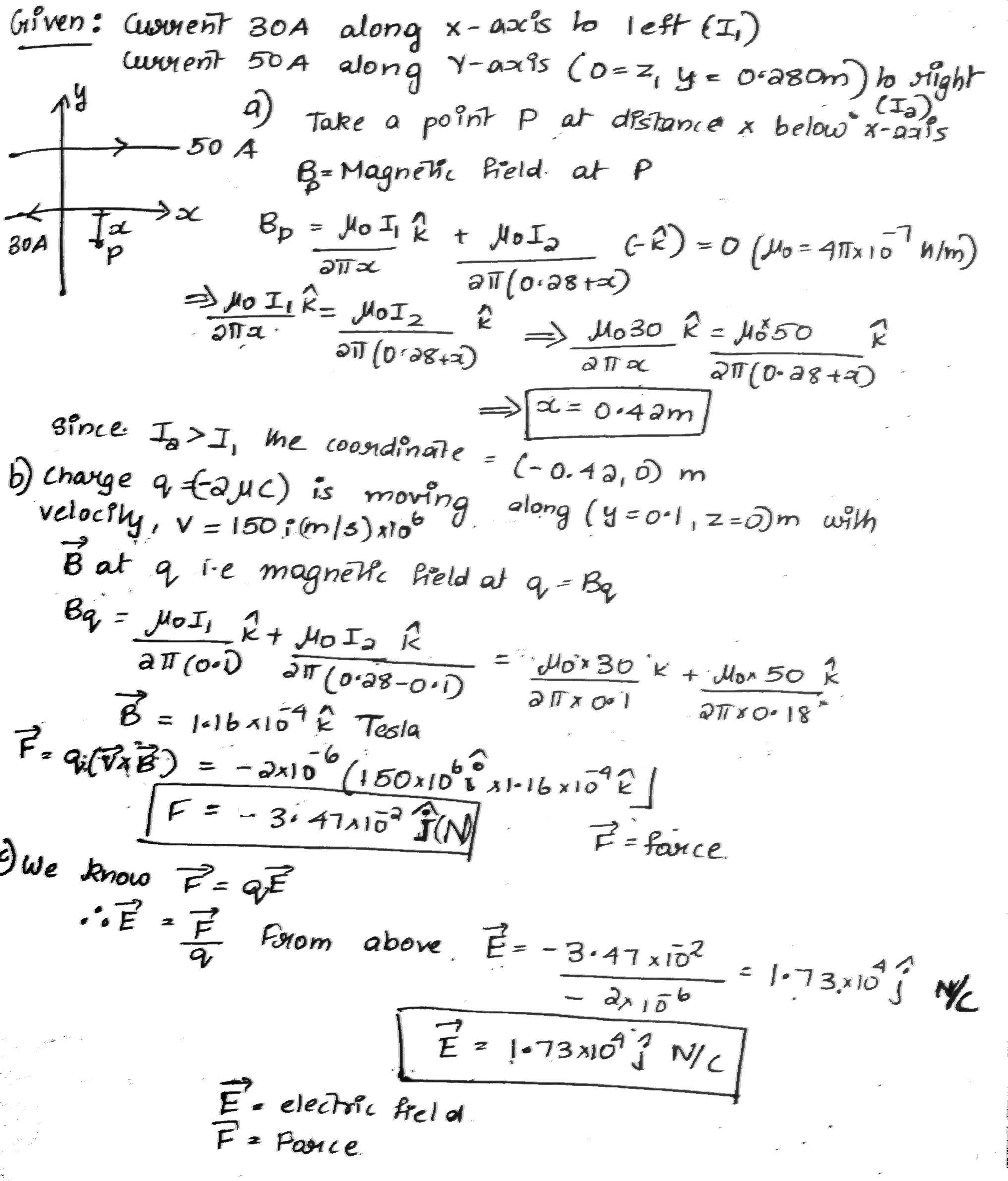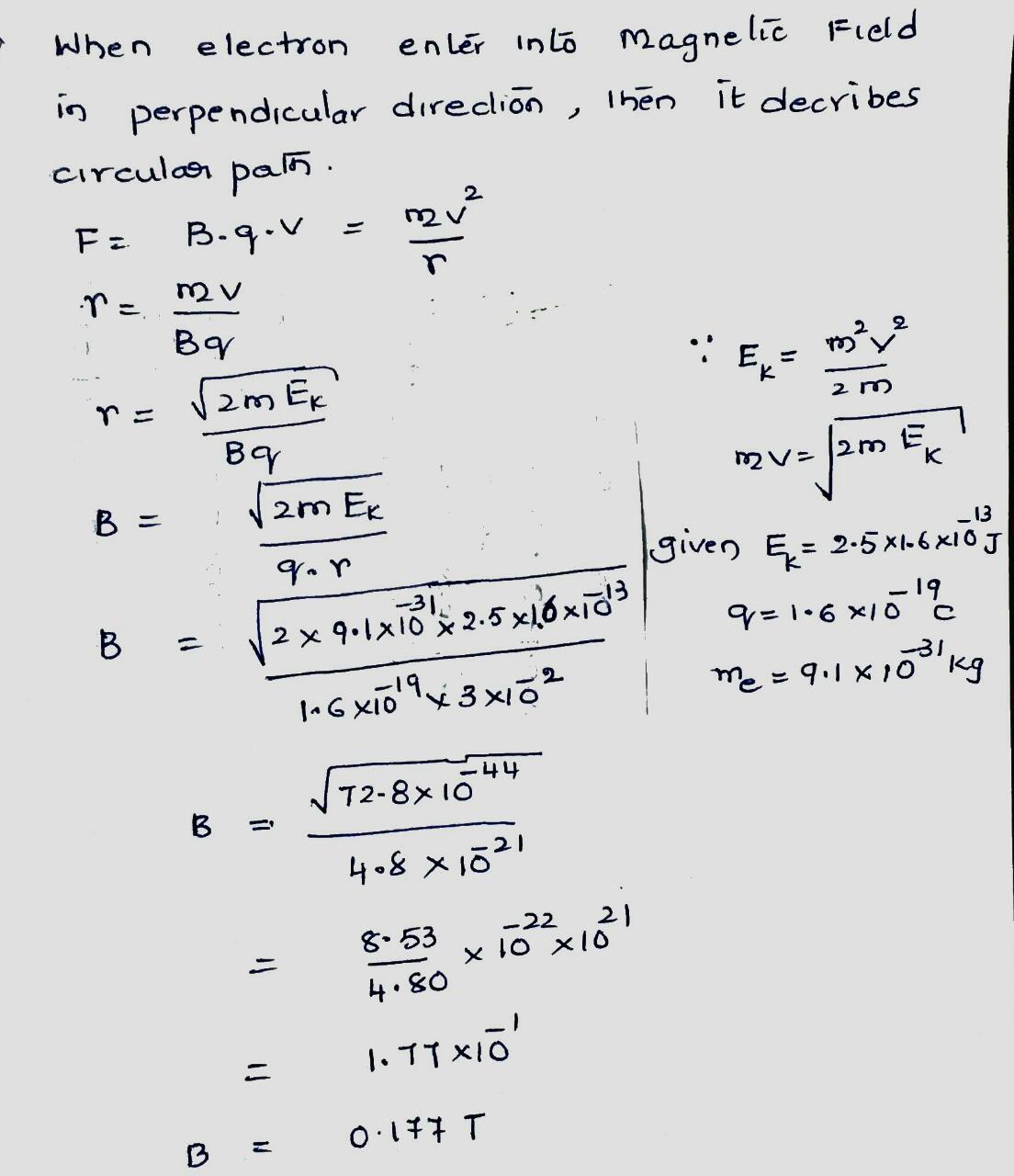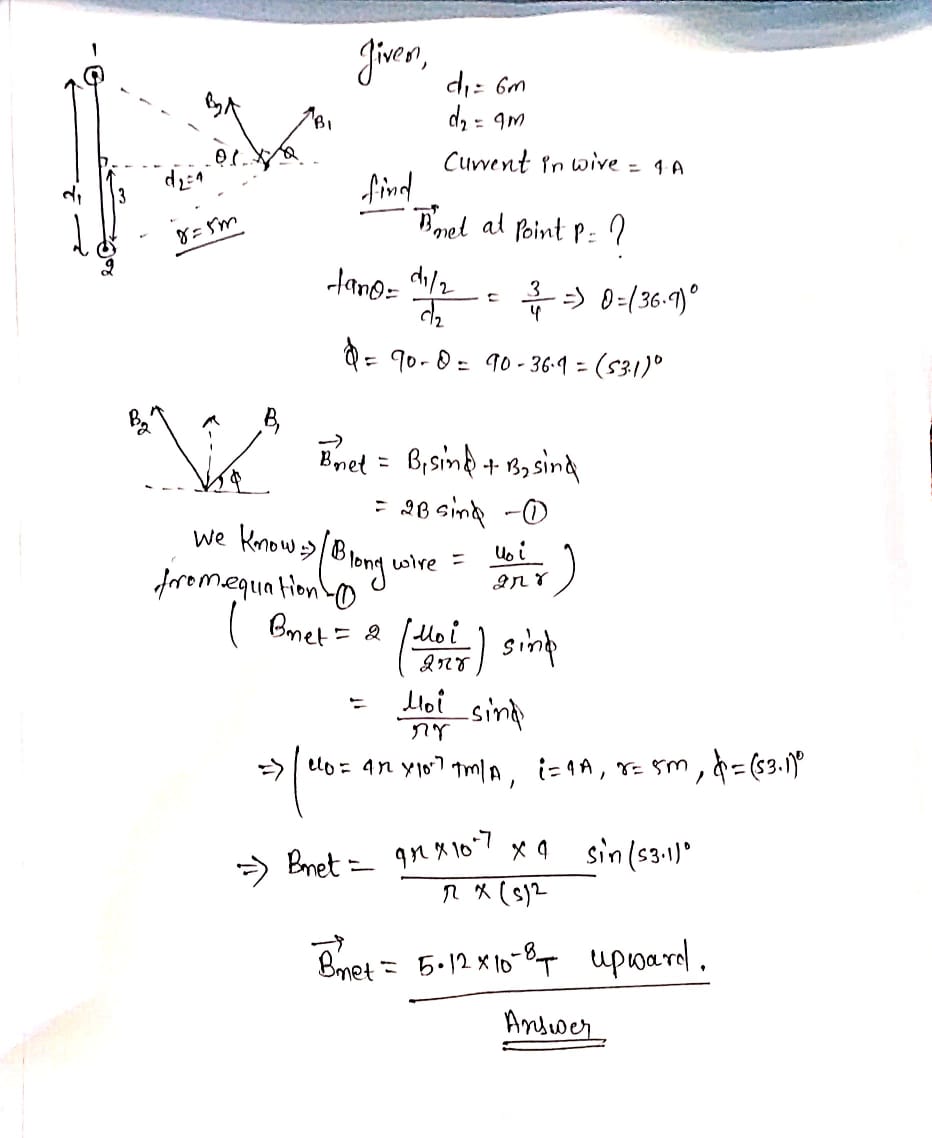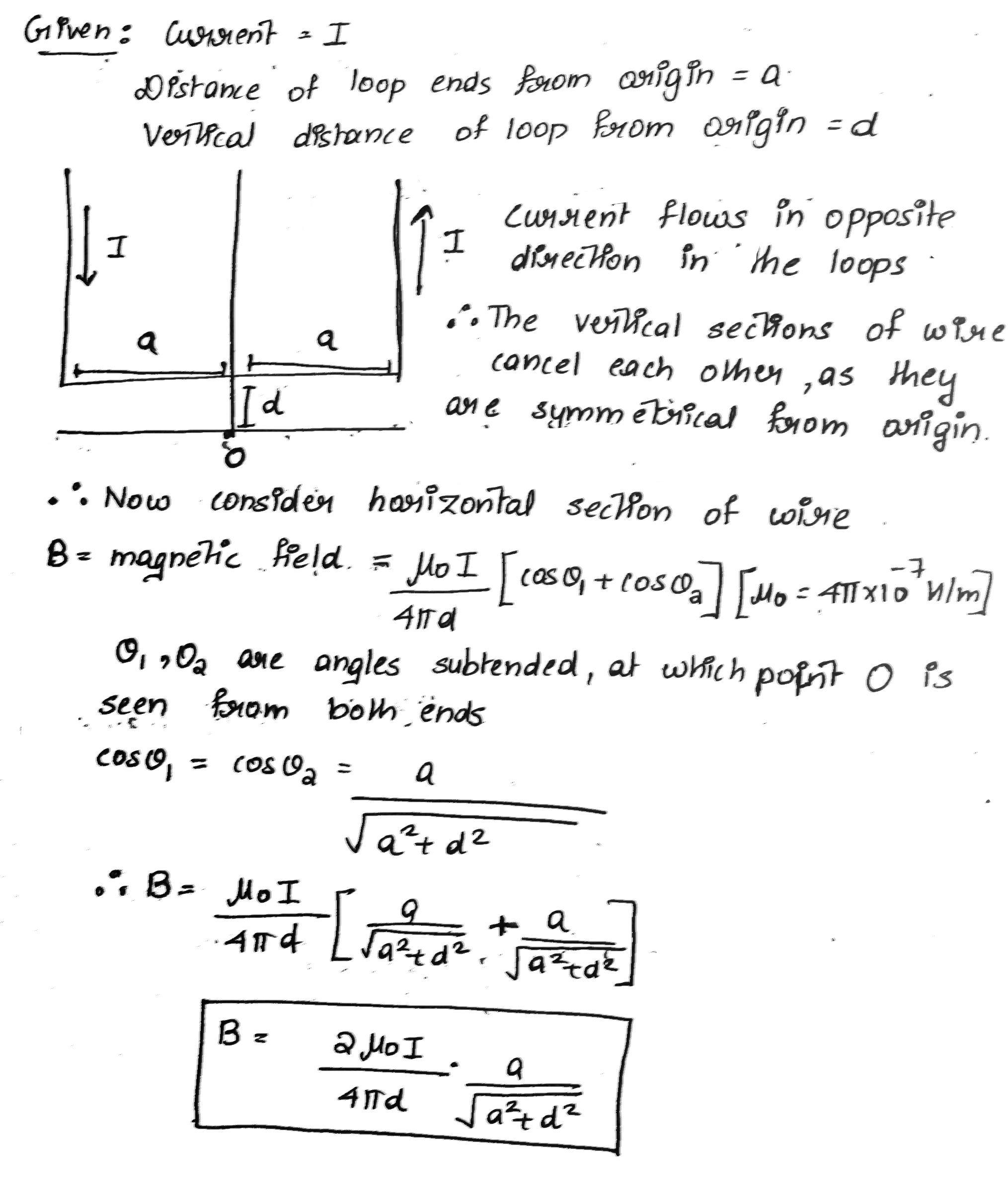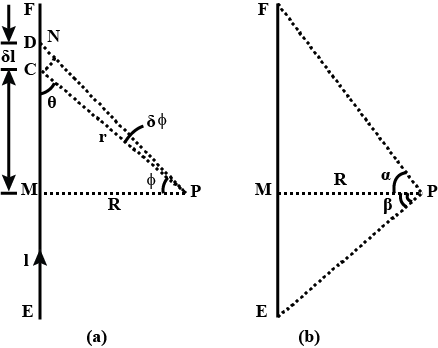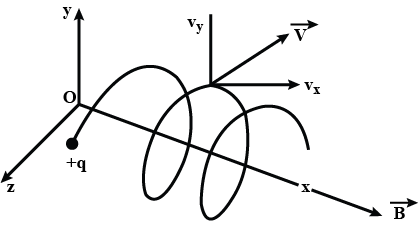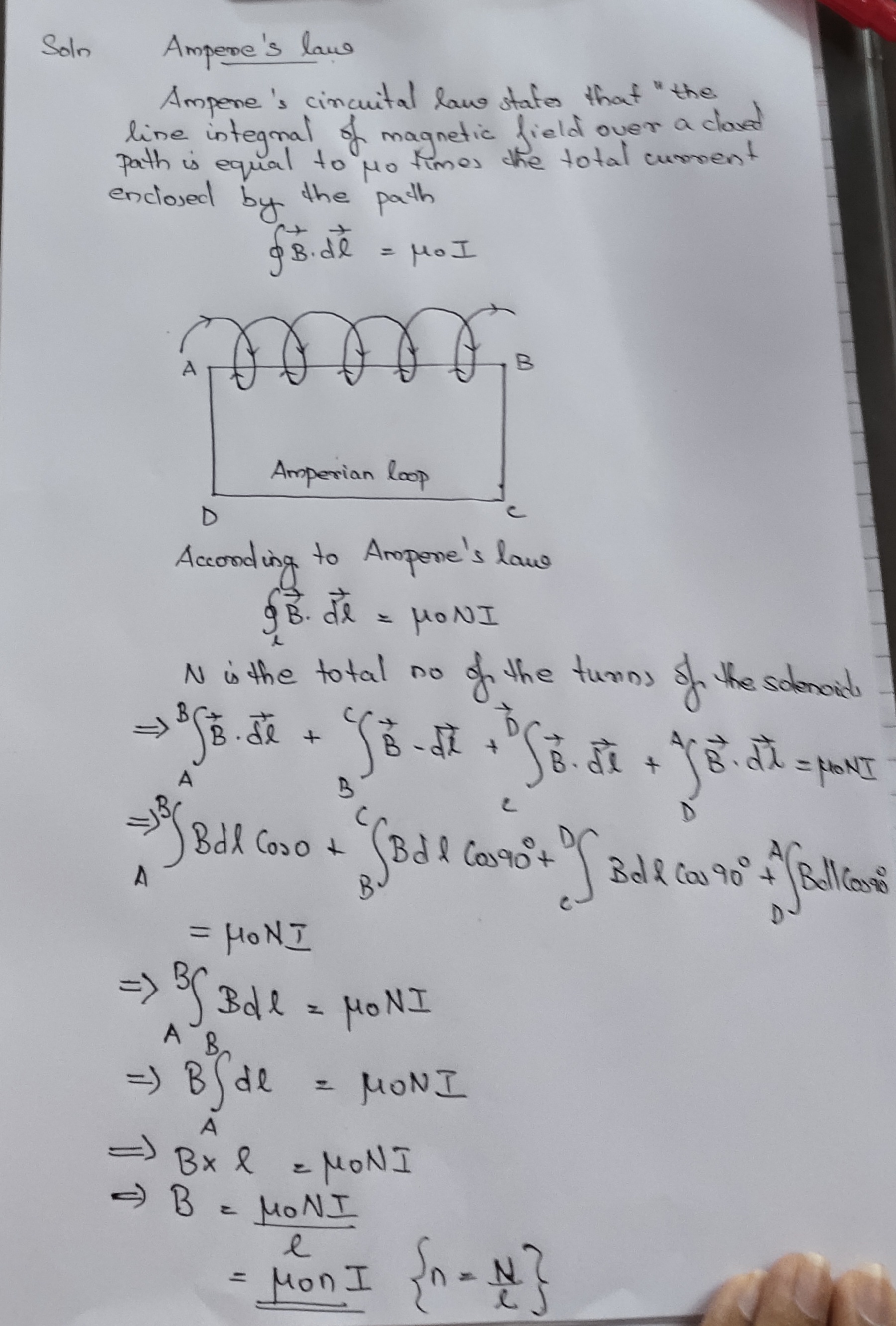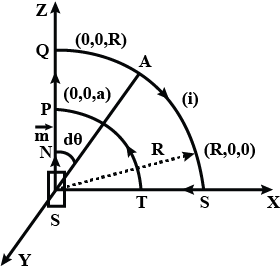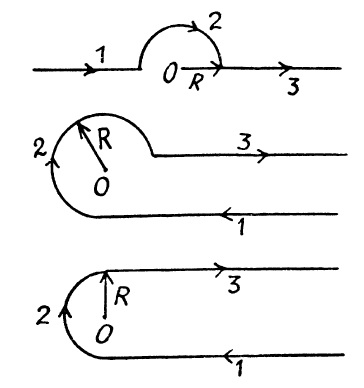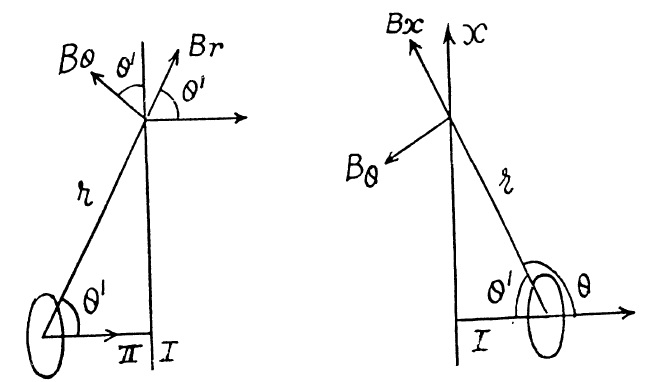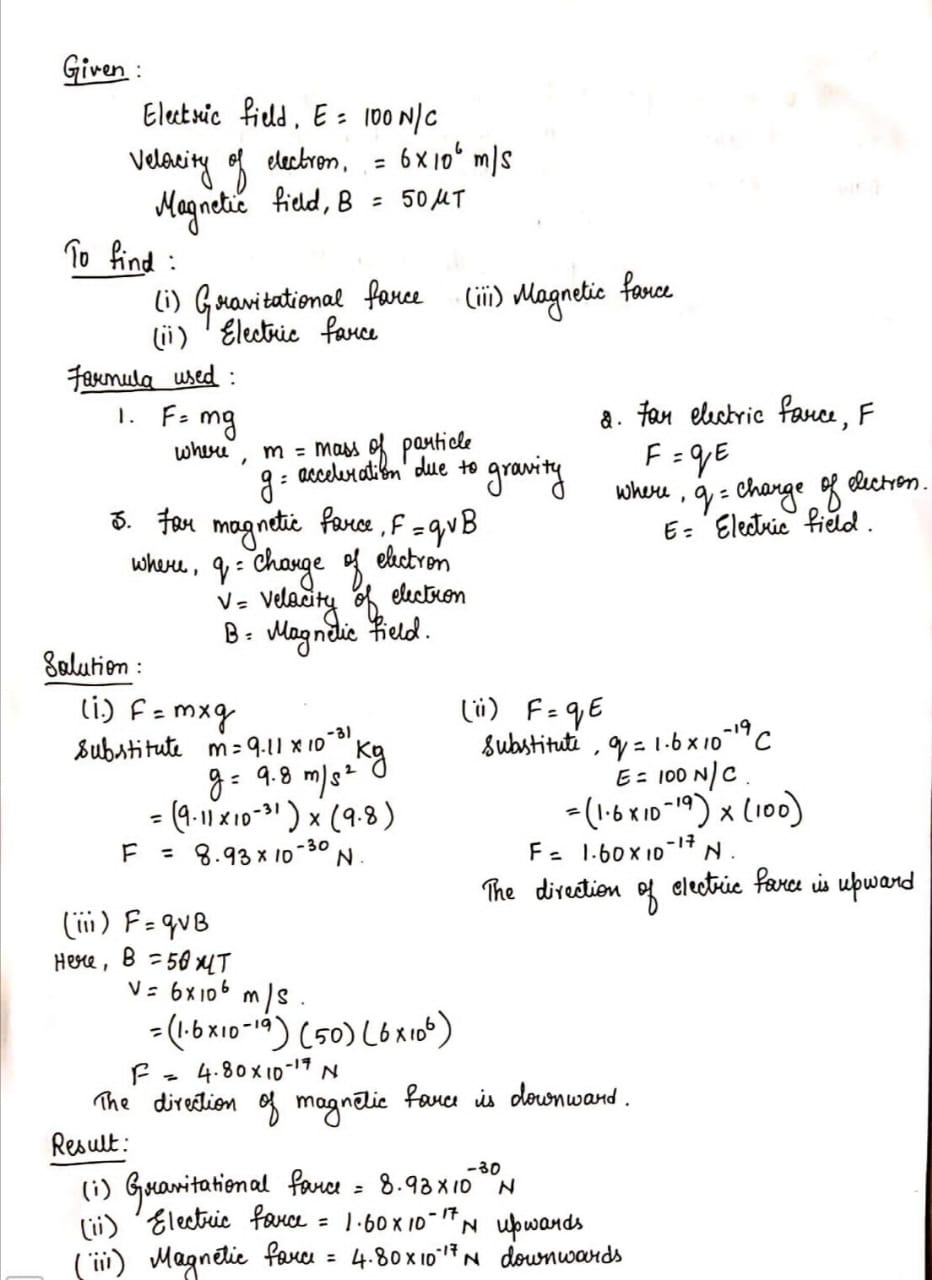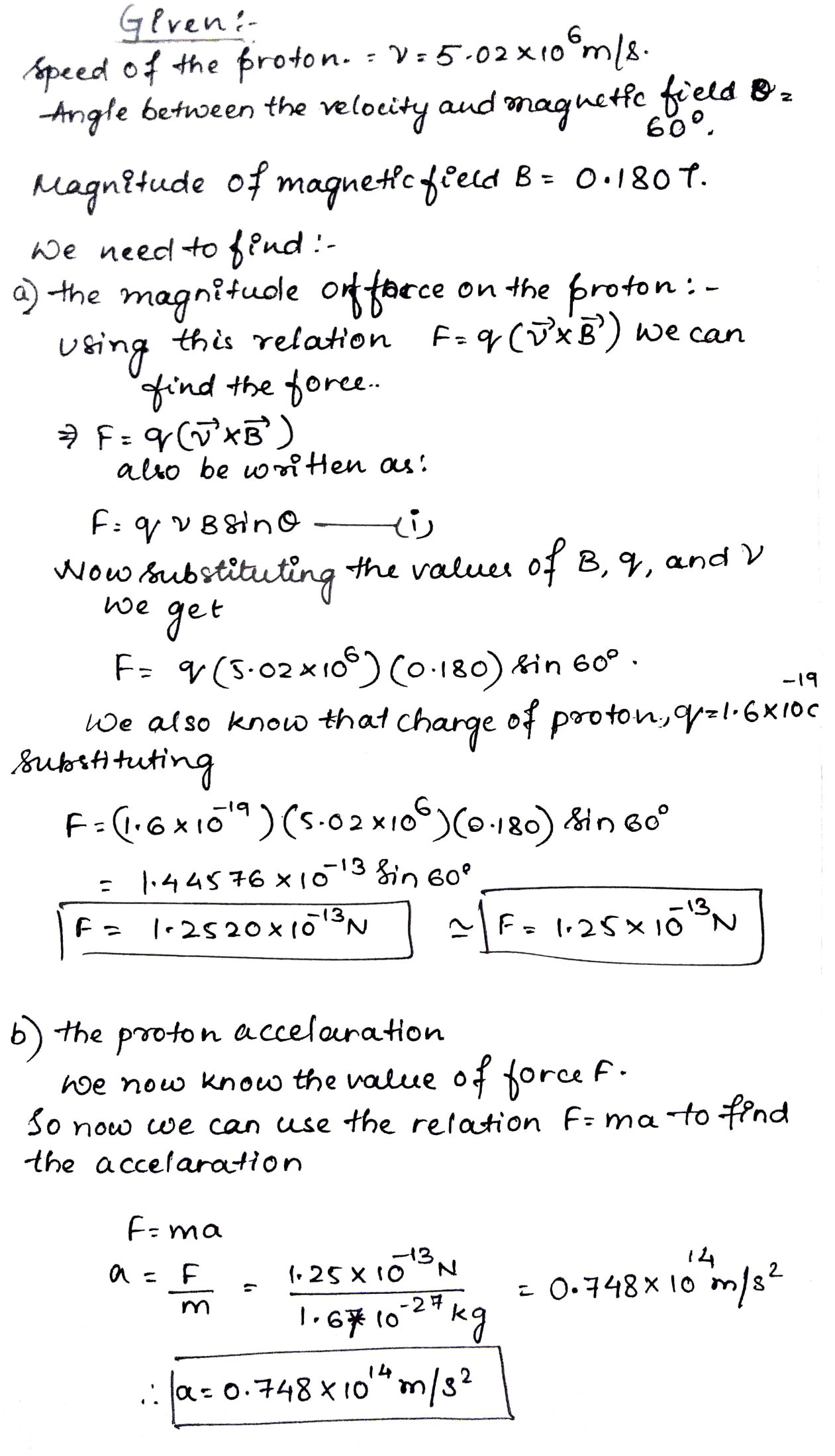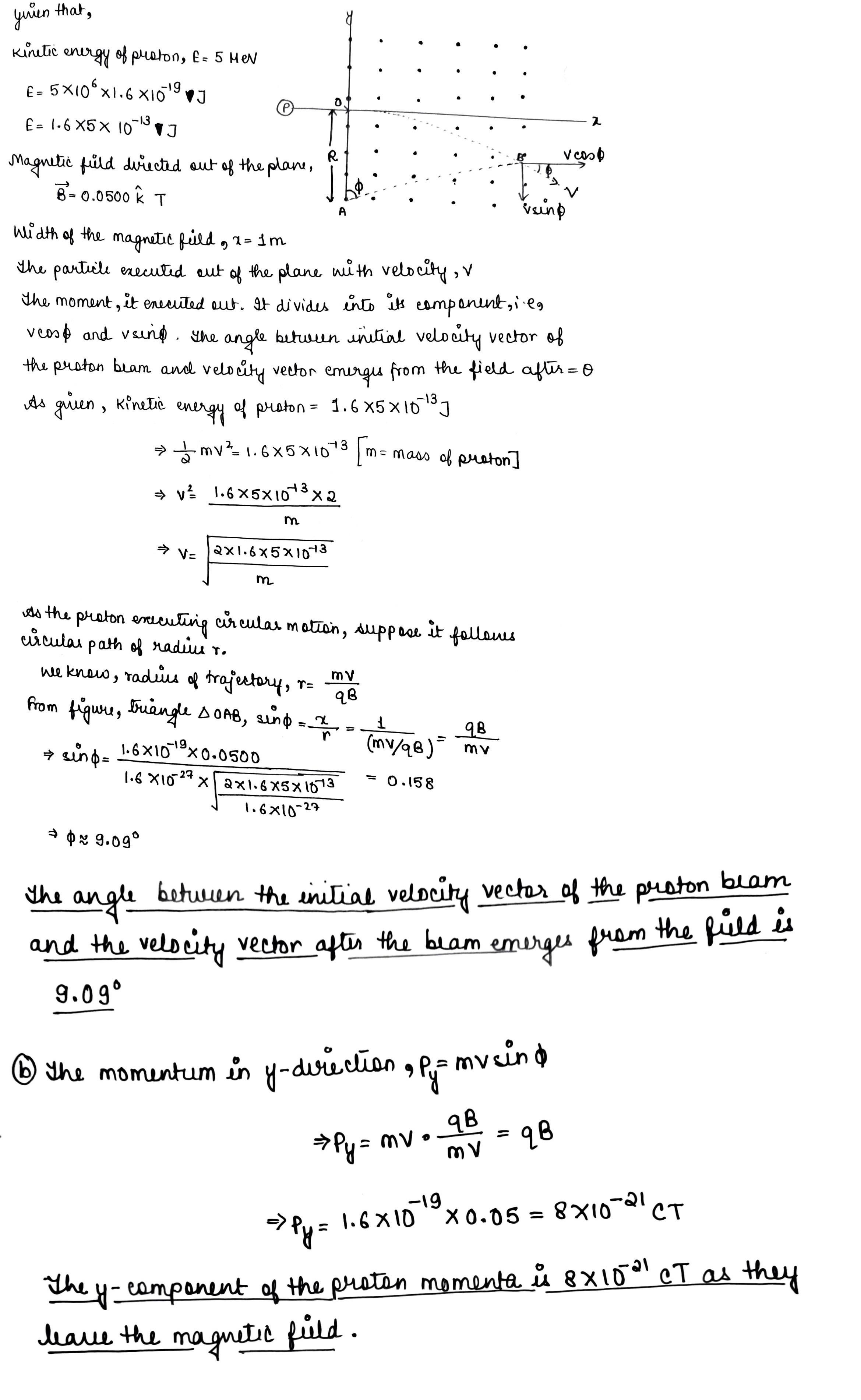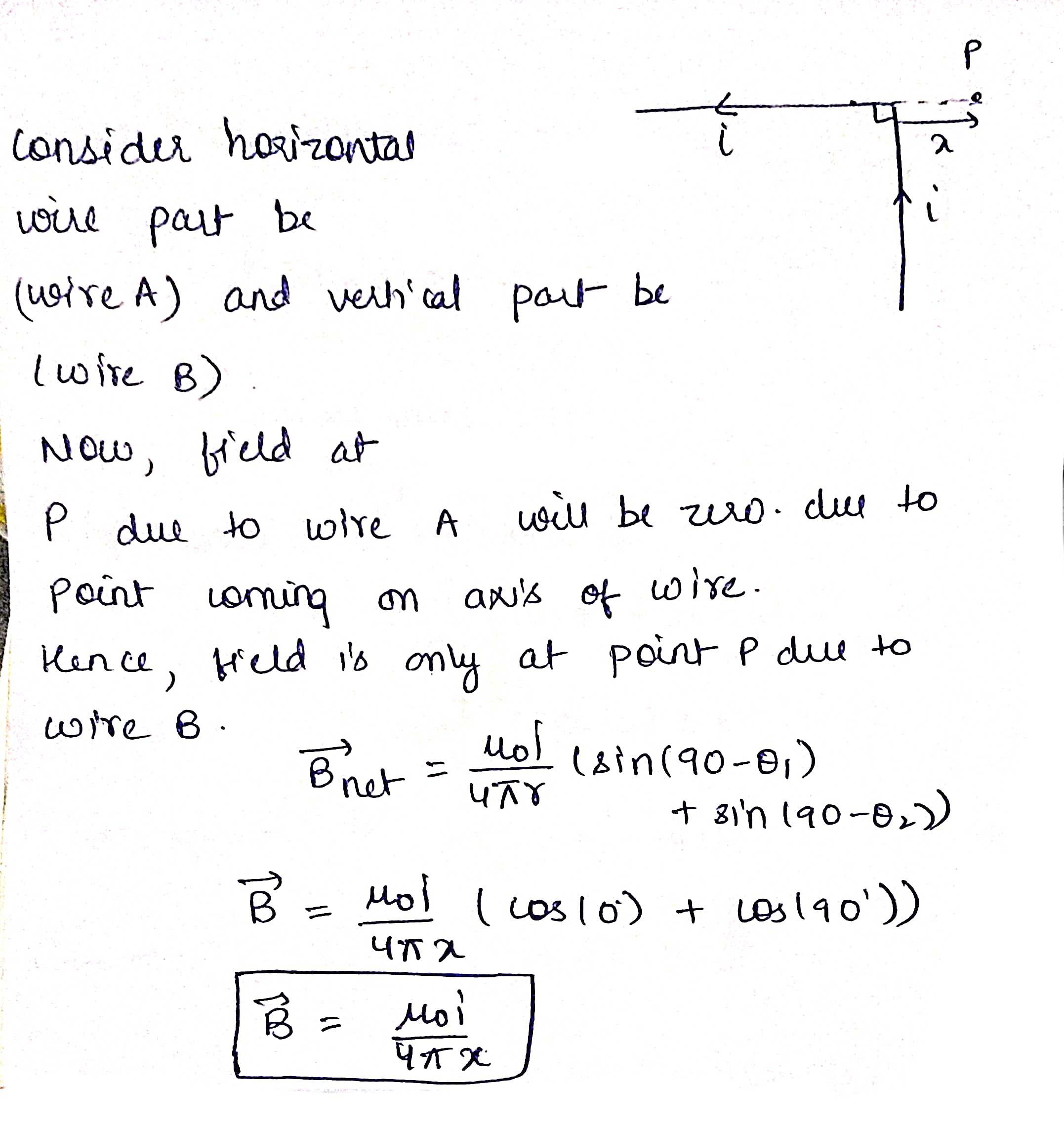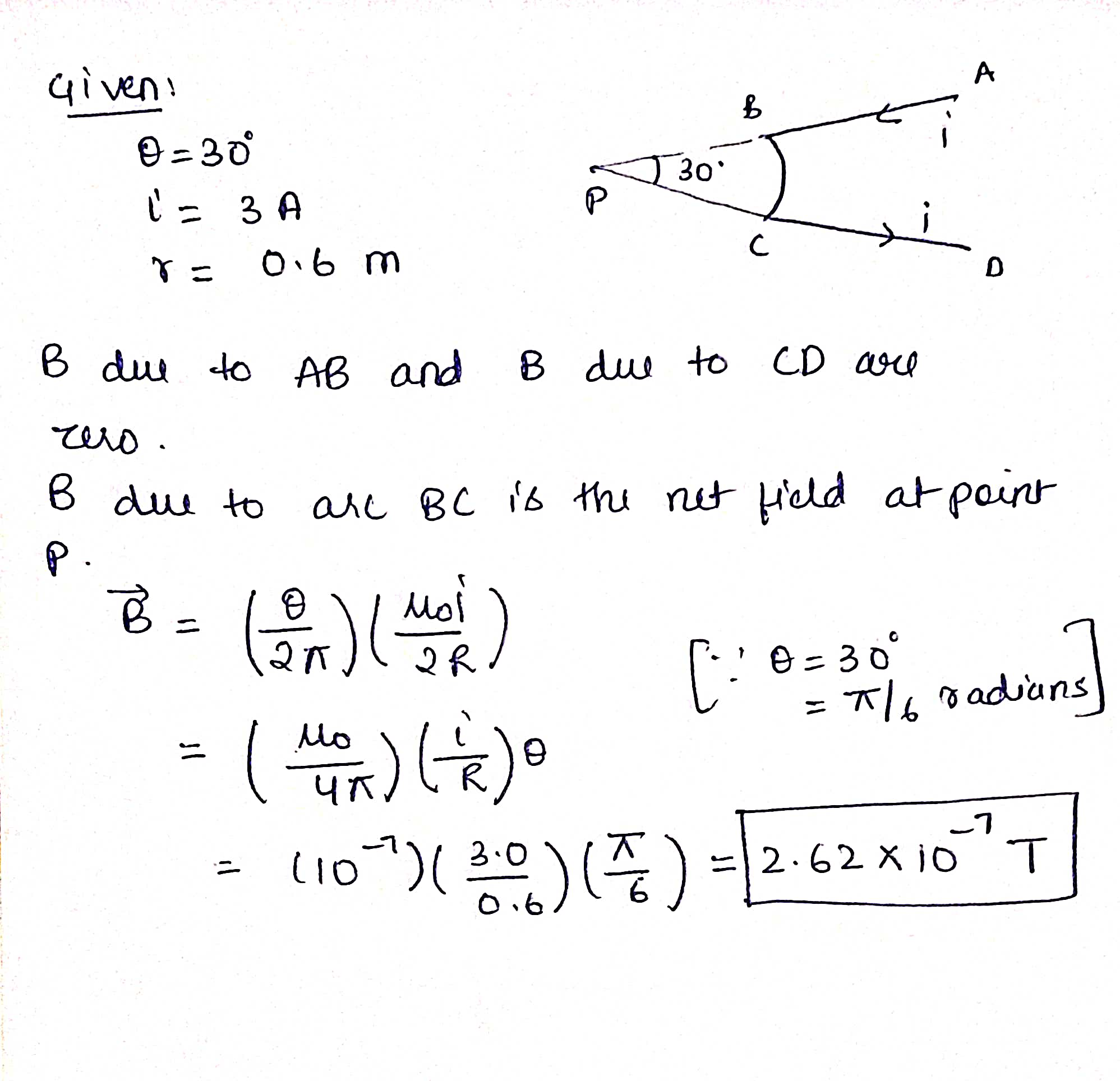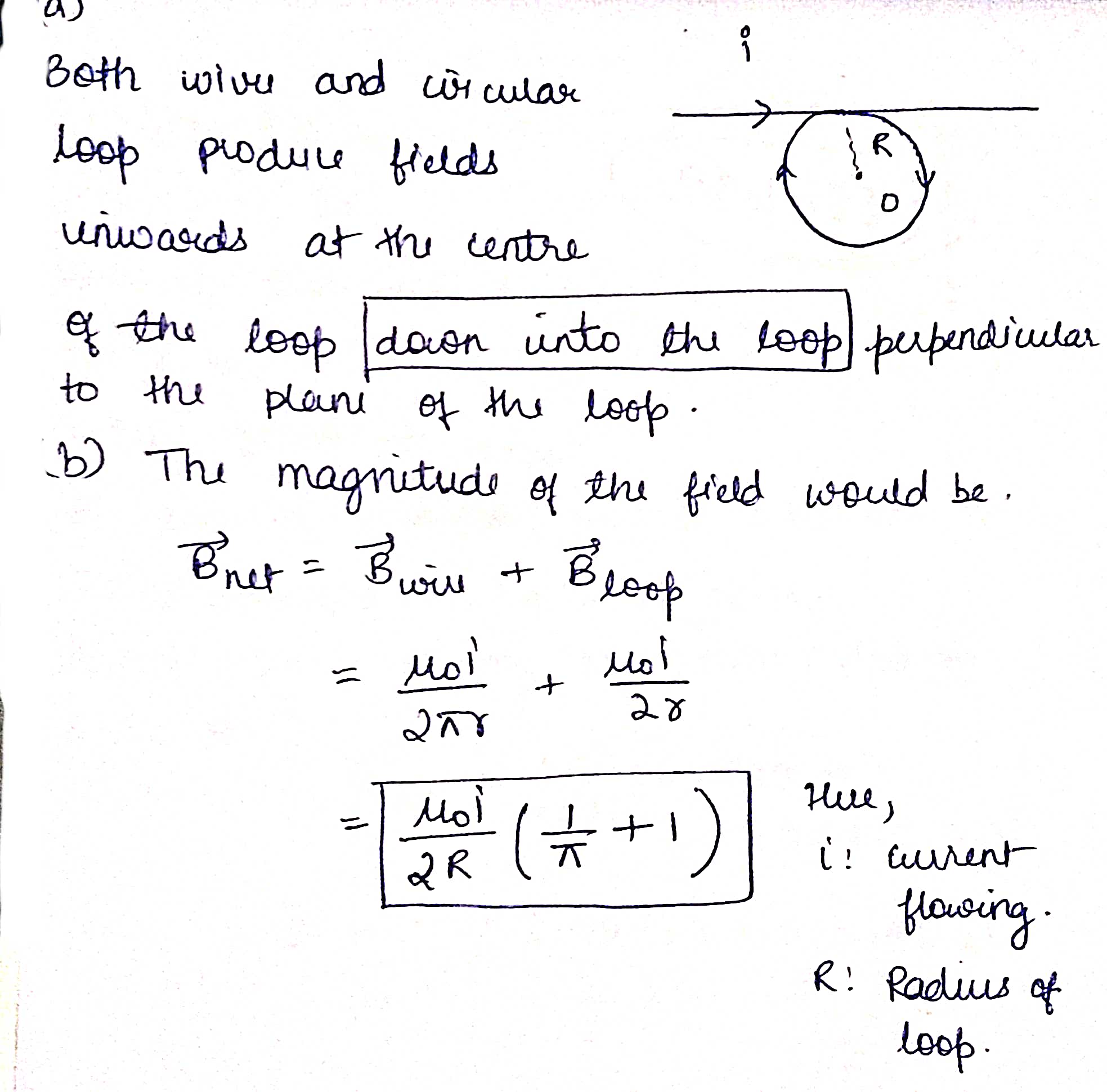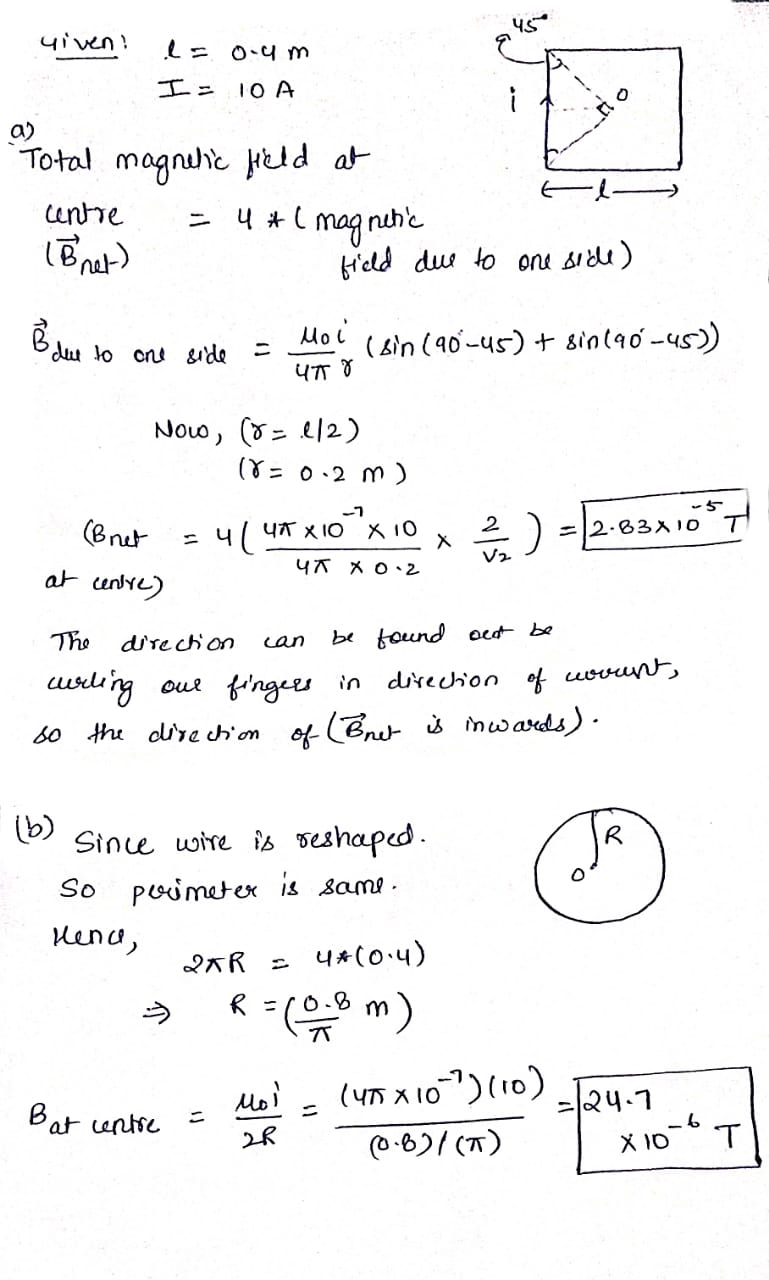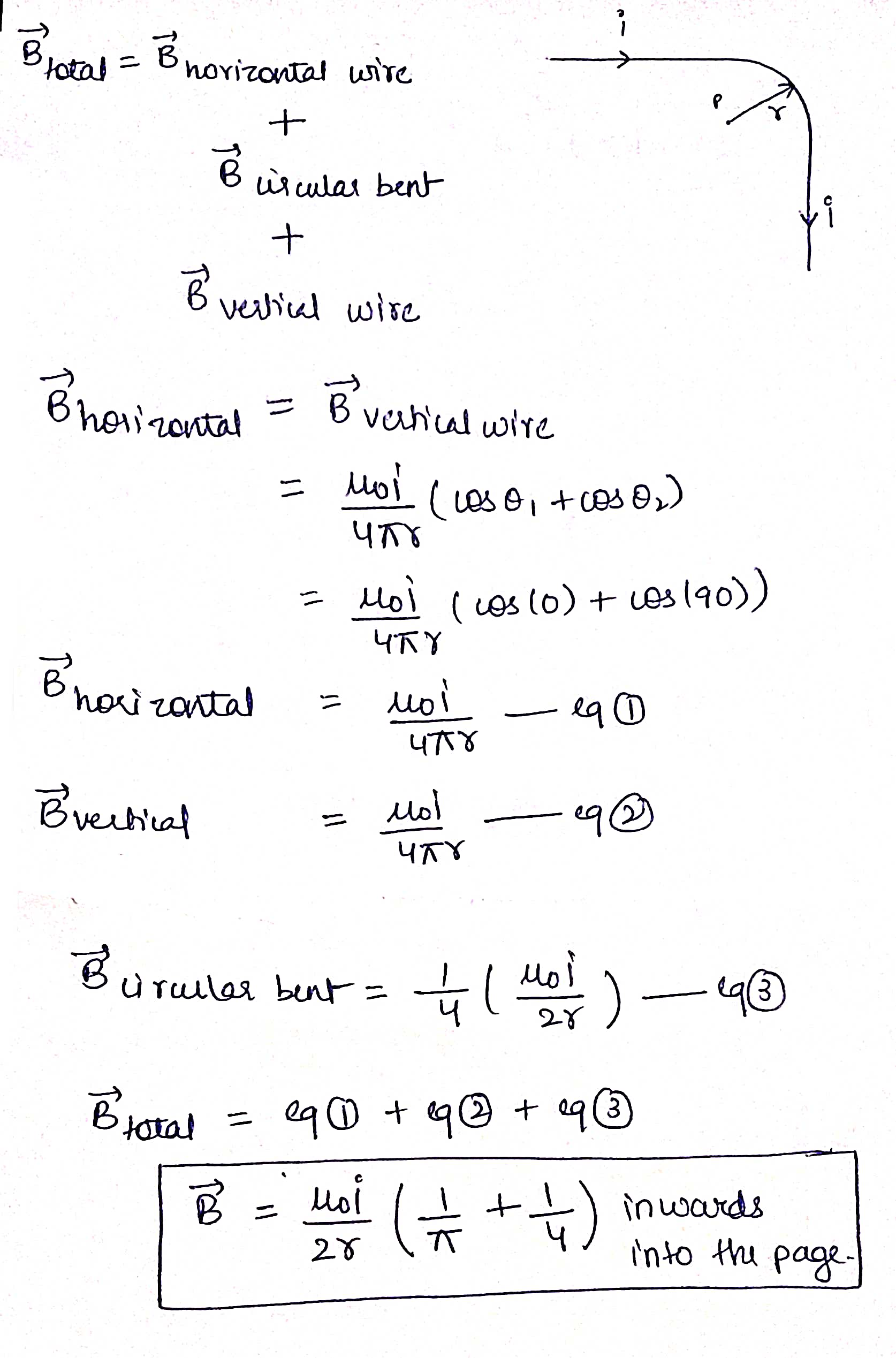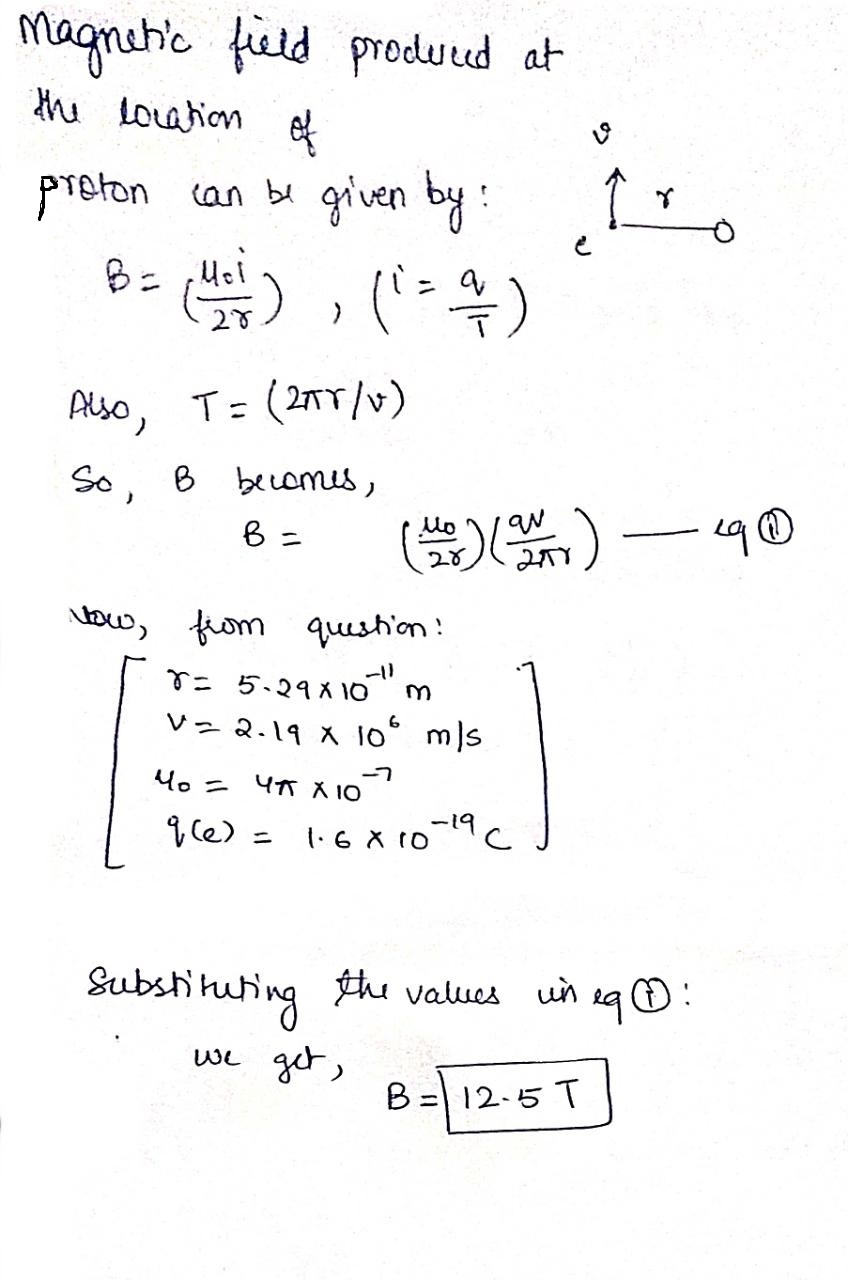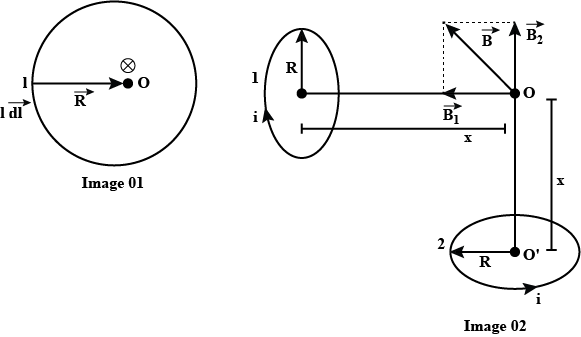Moving Charges And Magnetism - Class 12 Medical Physics - Extra Questions
In a nuclear experiment a proton with kinetic energy $$1.0 MeV$$ moves in a circular path in a uniform magnetic field. What energy must
(a) an alpha particle ($$q=+2e, m = 4.0 u$$) and
(b) a deuteron ($$q=+e, m = 2.0 u$$) have if they are to circulate in the same circular path?
The Biot-Savart Law(14)
In a long, straight, vertical lightning stroke, electrons move downward and positive ions move upward and constitute a current of magnitude $$20.0 \,kA$$. At a location $$50.0 \,m$$ east of the middle of the stroke, a free electron drifts through the air toward the west with a speed of $$300 \,m/s$$.
(a) Make a sketch showing the various vectors involved. Ignore the effect of the Earths magnetic field.
(b) Find the vector force the lightning stroke exerts on the electron.
(c) Find the radius of the electron's path.
(d) Is it a good approximation to model the electron as moving in a uniform field? Explain your answer.
(e) If it does not collide with any obstacles, how many revolutions will the electron complete during the $$60.0-\mu s$$ duration of the lightning stroke?
The Biot-Savart Law(19)
The two wires shown in Figure are separated by $$d = 10.0 \,cm$$ and carry currents of $$I = 5.00 \,A$$ in opposite directions. Find the magnitude and direction of the net magnetic field
(a) at a point midway between the wires;
(b) at point $$P_1, \,10.0 \,cm$$ to the right of the wire on the right; and
(c) at point $$P_2, \,2d = 20.0 \,cm$$ to the left of the wire on the left.
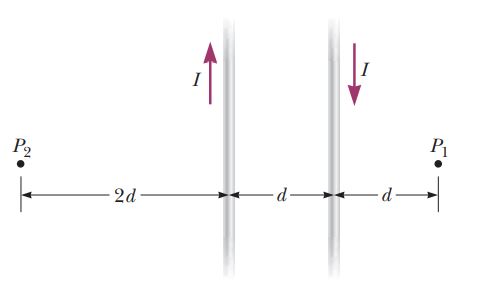
The Biot-Savart Law(20)
Two long, parallel wires carry currents of $$I_1 = 3.00 \,A$$ and $$I_2 = 5.00 \,A$$ in the directions indicated in Figure.
(a) Find the magnitude and direction of the magnetic field at a point midway between the wires.
(b) Find the magnitude and direction of the magnetic field at point $$P$$, located $$d = 20.0 \,cm$$ above the wire carrying the $$5.00-A$$ current.
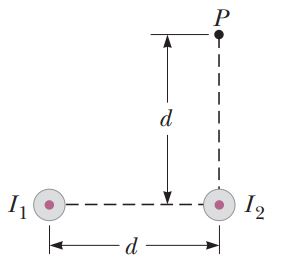
The Biot-Savart Law(14)
Three long, parallel conductors each carry a current of $$I = 2.00 A$$. Figure is an end view of the conductors, with each current coming out of the page. Taking $$a = 1.00 \,cm$$, determine the magnitude and direction of the magnetic field at
(a) point A,
(b) point B, and
(c) point C.
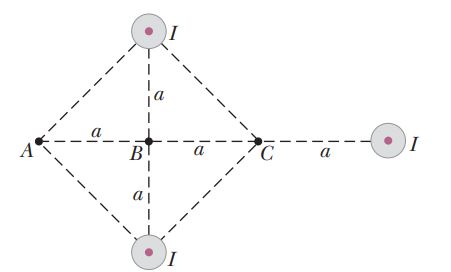
The Magnetic Force Between Two Parallel Conductors (27)
Two long, parallel wires are attracted to each other by a force per unit length of $$320 \mu \,N/m$$. One wire carries a current of $$20.0 \,A$$ to the right and is located along the line $$y = 0.500 \,m$$. The second wire lies along the x axis. Determine the value of $$y$$ for the line in the plane of the two wires along which the total magnetic field is zero.
The Biot-Savart Law(18)
A wire carrying a current $$I$$ is bent into the shape of an equilateral triangle of side $$L$$.
(a) Find the magnitude of the magnetic field at the center of the triangle.
(b) At a point halfway between the center and any vertex, is the field stronger or weaker than at the center?Give a qualitative argument for your answer.
Ampres Law(30)
Figure is a cross-sectional view of a coaxial cable. The center conductor is surrounded by a rubber layer, an outer conductor, and another rubber layer. In a particular application, the current in the inner conductor is $$I_1 = 1.00 \,A$$ out of the page and the current in the outer conductor is $$I_2 = 3.00 \,A$$ into the page. Assuming the distance $$d = 1.00 \,mm$$, determine the magnitude and direction of the magnetic field at
(a) point a and
(b) point b.
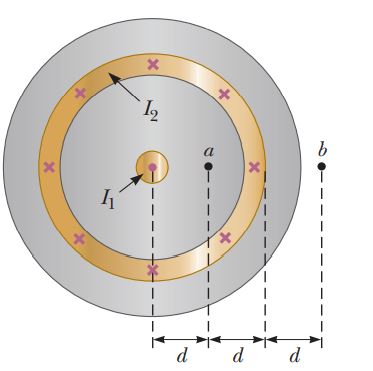
A conductor consists of a circular loop of radius $$R=10\ cm$$ and two straight, long sections as shown in figure.The wire lies in the plane of the paper and carries a current of $$i=7.00\ A$$. Determine the magnitude and direction of the magnetic field at the centre of the loop.
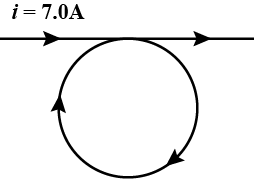
Are there components of the magnetic field that are not determined by the measurement of the force?Explain
An electron moves through a uniform magnetic field given by $$\vec{B}={B}_{x}\hat{i}+(3{B}_{x})\hat{j}$$.At a particular instant,the electron has the velocity $$\vec{v}=(2.0\hat{i}+4.0\hat{j})m/s$$ and the magnetic force acting on it is $$(6.4\times {10}^{-19}N)\hat{k}$$.Find $$x$$ such that $$x=-{B}_{x}$$.
Repeat your calculation for a proton having the same velocity.
Calculate the scalar product $$\vec{B}\cdot \vec{F}$$.What is the angle between $$\vec{B}$$ and $$\vec{F}$$ ?
Through what potential difference would the deuteron have to be accelerated to acquire this speed?
If $$F$$ is the force acting on the electron, find $$x$$ such that $$x=F\times {10}^{16}$$.
Two 2 m long parallel wires are placed in vacuum at a distance 0.2 m. If current 0.2 A flows in both the wires in the same direction, calculate the force acting per unit length between them.
Write the expression for magnetic potential energy of a magnetic dipole kept in a uniform magnetic field and explain the terms.
An electron is moving along x-axis in x-y plane with velocity of $${10}^{2}m/s$$. A magnetic field of magnitude $$10T$$ is present in the region along z-axis. If the magnitude of force on the particle is $$1.6m\times {10}^{-16}N$$, find $$m$$
What is the magnetic force per unit length experienced by wire C as shown in figure ? (Assume that all wires are parallel and indefinitely long)
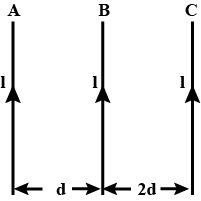
A circular coil of $$N$$ turns and diameter $$d$$ carries a current $$I$$. It is unwounded and rewound to make another coil of diameter $$2d$$ $$I$$ remaining the same. Calculate the ratio of the magnetic moments of the new coil and the original coil.
Give the principle of moving coil galvanometer? What is the advantage of radial magnetic field in the galvanometer?
A slightly divergent beam of non-relativistic charged particles accelerated by a potential difference $$V$$ propagates from a point $$A$$ along the axis of a straight solenoid. The beam is brought into focus at a distance $$l$$ from the point $$A$$ at two successive values of magnetic induction $$B_{1}$$ and $$B_{2}$$. Find the specific charge $$q/m$$ of the particles.
An alpha particle is projected vertically upward with a speed of $$3.0\times {10}^{4}km$$ $${s}^{-1}$$ in a region where a magnetic field of magnitude $$1.0T$$ exists in the direction south to north. Find the magnetic force that acts on the $$\alpha$$ particle.
A magnetic field of $$\left( {4.0 \times {{10}^{ - 3}}\vec k} \right)T$$ exerts a force of $$\left( {4.0\vec i + 3.0\vec j} \right) \times {10^{ - 10}}N$$ on a particle having a charge of $$1.0 \times {10^{ - 9}}C$$ and going in the X-Y plane. Find the velocity of the particle.
A cyclotron's oscillator frequency is $$10\ MHz$$. What should be the operating magnetic field for accelerating protons? If the radius $$r$$ its 'dees' is $$60\ cm$$, calculate the kinetic energy (in $$MeV$$) of the proton beem produces by the accelerator.
Answer the following:
What is it necessary to introduce a cylindrical soft iron core inside the coil of a galvanometer?
What should be the orientation of a magnetic dipole in a uniform magnetic field so that its potential energy is maximum?
The magnitude $$F$$ of the force between two straight parallel current carrying conductors kept at a distance $$d$$ apart in air is given by
$$F=\dfrac {\mu_0 I_1 I_2}{2\pi d} $$
Where $$I_1$$ and $$I_2$$ are the currents flowing through the two wires.
Use this expression, and the sign convention that the:
Force of attraction is assigned a negative sign and force of repulsion is assigned a positive sign.'
Draw graphs showing dependence of $$F$$ on
$$d$$ when the product $$I_1 I_2$$ is maintained at a constant positive value.
(a) How would you demonstrate that a momentary current can be obtained by the suitable use of a magnet. a coil of wire and a galvanometer?
(b) What is the source of energy associated with the current obtained in part(a)?
Why are the polar pieces of stable magnetic used in a galvanometer made of concave shape?
Write the mathematical form of Ampere's circuital law.
A cyclotrons dee radius is $$0.5m$$ and $$1.7T$$ cross-sectional magnetic field is working. Calculate the maximum kinetic energy gained by the proton.
Show how does a small circular carrying loop behave as a magnetic dipole?
Explain Biot-Savart's law. Derive the magnetic field generated by a straight and finite-length current-carrying conductor with the helo of this law. Show that the magnetic field at a perpendicular distance $$d$$ from an infinite length currently carrying conductor is $$B=\cfrac { { \mu }_{ 0 }I }{ 2\pi d } $$
Define Biot-Savart's law in vector form.
Two $$2m's$$ long parallel wires are placed in vacuum at a distance $$0.2m$$. If current $$0.2A$$ flows in both the wires in the same direction, calculate the force acting per unit length of the coil.
What is the initial angle in degrees between the dipole moment and the magnetic field?
$$x=0,y=-0.500 m,z=0$$
If M is the magnitude of the magnetic field, find $$x$$ such that $$x=100\times M$$.
Each of the lettered points at the corners of the cube in figure represents a positive charge q moving with a velocity of magnitude v in the direction indicated.The region in the figure is in a uniform magnetic field $$\vec{B}$$,parallel to the x-axis and directed toward the right .Find the magnitude and direction of the force on each charge.
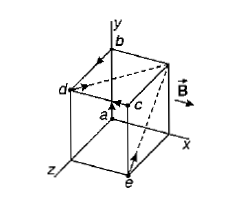
A circular loop of radius R carries current $${I}_{2}$$ in a clockwise direction as shown in figure. The centre of the loop is a distance D above a long,straight wire.What are the magnitude and direction of the current $${I}_{1}$$ in the wire if the magnetic field at the centre of loop is zero?
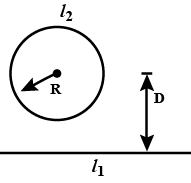
A $$-4.80\mu C$$ charge is moving at a constant velocity of $$6.80\times {10}^{5}m/s$$ in the +x direction relative to a reference frame.At the instant when the point charge is at the origin,what is the magnetic field vector it produces at the following points x=0,y=0.500 m,z=0?
A particular type of fundamental particle decays by transforming into an electron $$e^{-}$$ and a positron $$e^{+}$$. Suppose the decaying particle is at rest in a uniform magnetic field $$\vec{B}$$ of magnitude $$3.53 mT$$ and the $$e^{-}$$ and $$e^{+}$$ move away from the decay point in paths lying in a plane perpendicular to $$\vec{B}$$. How long after the decay do the $$e^{-}$$ and $$e^{+}$$ collide?
Is the magnetic dipole moment a vector or a scalar quantity? Write its unit.
A moving charged particle q travelling along the positive x-axis enters a uniform magnetic field B. When will the force acting on q be maximum?
The magnetic moment of a thin round loop with current, if the radius of the loop is equal to $$R=100\:mm$$ and the magnetic field at its centre is equal to $$B=6.0\:\mu T$$, is $$30 \times 10^{-x} A-m^2$$. Find the value of $$x$$.
If the expression in vector form, for the magnetic force $$\vec F$$ acting on a charged particle moving with velocity $$\vec V$$ in the presence of a magnetic field $$\vec B$$ is given by $$\overrightarrow { F } =a*q\overrightarrow { v } \times \overrightarrow { r } $$. Find a.
If the magnetic moment of the coil is $$36 \times 10^{-X} Am^2$$. Find $$X$$?
Find out the angle(in degrees) at which an electron moving through a magnetic field experiences the maximum force.
If expressions for the magnetic field at a point due to a current element, in C.G.S.system is given by $$d\overrightarrow { B } =\frac { μ_{ 0 } }{ 4π } \frac { i(d\overrightarrow { l\times \overrightarrow { r } } ) }{ { a*r }^{ 3 } } $$. Find a.
Can a charged particle be accelerated by a magnetic field.Can its speed be increased?
Calculate the components of the magnetic field you can find from this information.
A closed curve encircles several conductors.The line integral $$\int{\vec{B}\cdot d\vec{l}}$$ around this curve is $$3.83\times {10}^{-7} T-m$$. If you were to integrate around the curve in the opposite direction, what could be the value of the line integral?
A circular coil of $$300$$ turns and average area $$5 \times {10}^{-3} {m}^{2}$$ carries a current of $$15 A$$. Calculate the magnitude of magnetic moment associated with the coil.
Draw a neat and labelled diagram of suspended coil type moving coil galvanometer.
A charge q enters perpendicularly with the direction of a magnetic field $$\bar{B}$$ with a velocity $$\bar{V}$$. What would be the force acting on this charge?
You are provided with one low resistance $$R_{L}$$ and one high resistance $$R_{H}$$ and two galvanometers. One galvanometer is to be converted to an ammeter and the other to a voltmeter. Show how you will do this with the help of simple, labelled diagrams
The Magnetic Force Between Two Parallel Conductors(22)
Two parallel wires separated by $$4.00 \,cm$$ repel each other with a force per unit length of $$2.00 \times 10^{-4} \,N/m$$. The current in one wire is $$5.00 \,A$$.
(a) Find the current in the other wire.
(b) Are the currents in the same direction or in opposite directions?
(c) What would happen if the direction of one current were reversed and doubled?
Write the expression for Lorentz magnetic force on a particle of charge $$'q'$$ moving with velocity $$\overset{\rightarrow}{v}$$ in a magnetic field $$\overset{\rightarrow }{B}$$.Show that no work is done by this force on the charged particle
A wire of a length 2 m carrying a current of 1 A is bend to form a circle. The magnetic moment of the coil is $$\left ( in A - m^{2} \right )$$:
(a) $$1/\pi $$
(b) $$\pi /2$$
Define watt. Write down an equation linking watts, volts and amperes.
A proton moving with velocity $$V$$ is acted upon by electric field $$E$$ and magnetic field $$B$$. The proton will move undeflected if
Observe the figure
Identify the device shown in the figure.
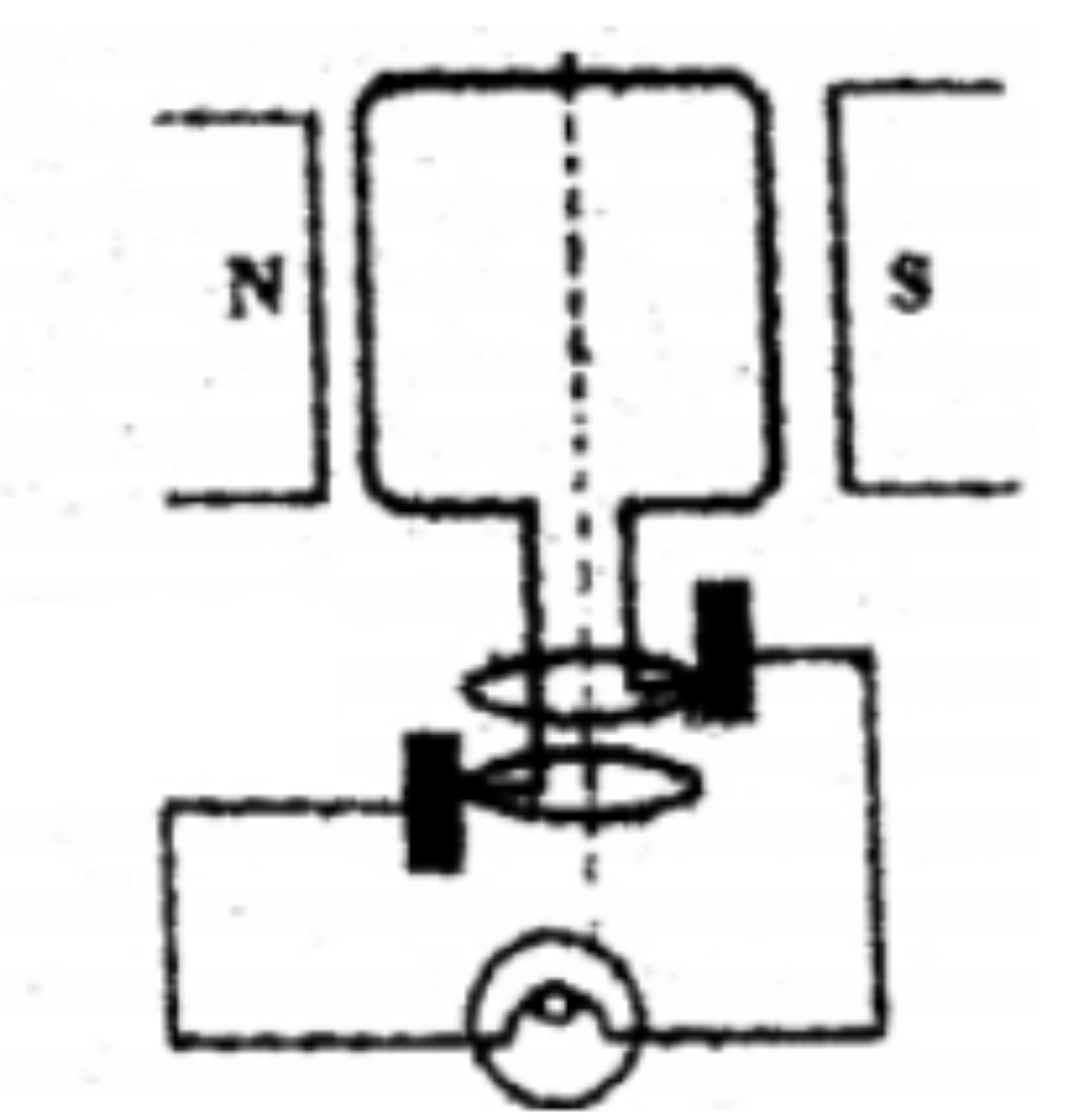
$$x=0,y=-0.500 m,z=+0.500 m$$
A solenoid has an inductance of $$1 0$$ henry and a resistance of $$2$$ ohm. It is connected to a $$10$$ volt battery. How long will it take for the magnetic energy to energy to reach $$1/4$$ of its maximum value?
A long circular tube of length $$10$$m and radius $$0.3$$m carries a current I along its curved surface as shown. A wire-loop of resistance $$0.005$$ ohm and of radius $$0.1$$m is placed inside the tube with its axis coinciding with the axis of the tube. The current varies as $$I=I_0\cos(300 t)$$ where $$I_0$$ is constant. If the magnetic moment of the loop is $$N\mu_oI_0\sin(300 t)$$, then 'N' is?
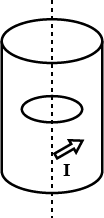
Answer the following question:
An electron moving horizontally with a velocity of $$4\times 10^4\ m/s$$ enters a region of uniform magnetic field of $$10^{-5}\ T$$ acting vertically downward as shown in the figure.
Draw its trajectory and find out the time it takes to come out of the region of magnetic field.
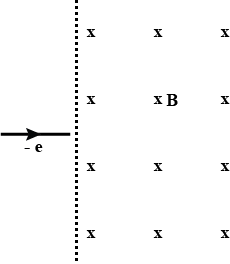
The Magnetic Force Between Two Parallel Conductors(21)
Two long, parallel conductors, separated by $$10.0 \,cm$$, carry currents in the same direction. The first wire carries a current $$I_1 = 5.00 \,A$$, and the second carries $$I_2 =8.00 \,A$$.
(a) What is the magnitude of the magnetic field created by $$I_1$$ at the location of $$I_2$$?
(b) What is the force per unit length exerted by $$I_1$$ on $$I_2$$?
(c) What is the magnitude of the magnetic field created by $$I_2$$ at the location of $$I_1$$?
(d) What is the force per length exerted by $$I_2$$ on $$I_1$$?
State the rule to determine the direction of current induced in a coil due to its rotation in a magnetic field.
In the relation $$\vec{F}=q(\vec{v}\times \vec{B})$$,which pairs are always perpendicular to each other.
___________ law gives the quantitative relationship between current and magnetic field due to the current carrying conductor.
State Ampere's circuital law.
What are the units of magnetic moments and magnetic induction?
Mention the significance of Lenz's law.
Explain inconsistency of Ampere's circuital law during charging of a capacitor.
Biot - savarts law
$$ dB^{\rightarrow}= \dfrac{\mu o}{4\pi}$$ $$\dfrac{idl^{\rightarrow }\times r^{\rightarrow }}{ | r |^{3}}$$
Express $$90$$cm as a percent of $$4.5$$m.
A charged particle is moving in a magnetic field, match the different quantities of a particle in entries of column I with the entries of column II.
Equal currents are flowing in four infintely long wires.Distance between two wires is same and directions of currents are shown in figure.Match the following two columns.

$$x=0.500 m, y=0, z=0$$
A short bar magnet of magnetic moment $$m = 0.32\, JT^{-1}$$ is placed in a uniform magnetic field of $$0.15 T$$. If the bar is free to rotate in the plane of the field, which orientation would correspond to its (a) stable, and (b) unstable equilibrium? What is the potential energy of the magnet in each case?
A bar magnet of magnetic moment $$1.5 J T^{-1}$$ lies aligned with the direction of a uniform magnetic field of 0.22 T.
(a) What is the amount of work required by an external torque to turn the magnet so as to align its magnetic moment: (i) normal to the field direction, (ii) opposite to the field direction?
(b) What is the torque on the magnet in cases (i) and (ii)?
State Biot - Savart law. Deduce the expression for the magnetic field at a point on the axis of a current carrying circular loop of radius 'R' distant 'x' from the center. Hence, write the magnetic field at the center of a loop.
A positively charged croquet ball rolls at 4.0 m/s northward through a 2.00 T magnetic field which points westward.
If the charge on the croquet ball is 1.0 C, how much force acts on the croquet ball due to the magnetic field and in what direction?
Write the expression, in a vector form, for the Lorentz magnetic force $$\overrightarrow F $$ due to a charge moving with velocity $$\overrightarrow V $$ in a magnetic field $$\overrightarrow B $$. What is the direction of the magnetic force?
(a) State Ampere's circuital law. Use this law to obtain the expression for the magnetic field inside an air cored toroid of average radius r having 'n' turns per unit length and carrying a steady current I.
(b) An observer to the left of a solenoid of N terms each of cross section area A observes that a steady current I in it flows in the clockwise direction. Depict the magnetic field lines due to the solenoid specifying its polarity and show that it acts as a bar magnet of magnetic momentum $$m = NIA$$
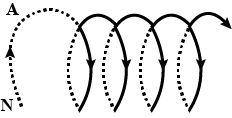
According to Ampere's swimming rule, if a man swims along a direction opposite to the direction of the current, south pole of the needle deflects towards his __________.
In a field, the force experienced by a charge depends upon its velocity and becomes zero, when it is at rest. What is the nature of the field?
Write the expression for the Lorentz force $$F$$ in vector form.
Explain how electric current with Lorentz-Drude theory of electrons.
A circular coil of $$250$$ turns and diameter $$18 cm$$ carries a current of $$12 A$$. What is the magnitude of magnetic moment associated with the coil ?
State Biot-Savart law.
State and explain Ampere's circuital law.
Write Biot-Savart law.
Write the path of motion of an electron when it enters in magnetic field at
(a) perpendicular
(b) an angle $$\theta$$.
The relation between magnetic field and current is given by Biot-Savart law. Illustrate Biot-Savart law with necessary figure.
State and explain Biot-Savart Law.
Write the special features of Magnetic Lorentz force.
State Biot-Savart's law? Define the unit of current.
A moving charge can produce a magnetic field. How does a current loop behaves like a magnetic dipole?
If a circular coil of $$100$$ turns and radius $$10$$cm carries a current of $$1$$A, find the magnetic dipole moment of the coil.
Define magnetization. Write its SI unit and dimensions.
State and explain Ampere's circuital law.
State Biot-Savart's law. Define unit of current.
A long circular tube of length $$10 m$$ and radius 0.3 m carries a current I along its curved surface as shown. A wire-loop of resistance 0.0005 ohm and of radius 0.1 m is placed inside the tube with its axis coinciding with the axis of the tube. The current varies as $$I=I_0 cos (300 t)$$ where $$ I_0$$ is constant. If the magnetic moment of the loop is $$ N\, \mu_0\,I_0 sin (300 t)$$, then 'N' is
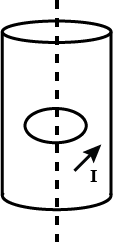
A uniform magnetic field of magnitude $$0.20\ T$$ exists in space from east to west. With what speed should a particle of mass $$0.010\ g$$ and having a charge $$1.0\times 10^{-5}C$$ be projected from south to north so that it moves with a uniform velocity?
Write Ampere circuital law in mathematical form. Derive an expression of magnetic field at the axis of a current carrying long solenoid. Draw necessary diagram.
A particle moves in a circle of diameter $$1.0\ cm$$ under the action of a magnetic field of $$0.40\ tesla$$. An electric field of $$200\ Vm^{-1}$$ makes the path straight. Find the charge/mass ratio of the particle.
(a) What is shunt?
(b) State Ampere's circuital law. Using the law, obtain an expression for the magnetic field well aside the solenoid of finite length.
A small magnetised needle $$P$$ placed at point $$O$$ and the arrow shows the direction of its magnetic moment. The other arrow shows different position and orientation of another identical magnets ($$Q$$). In which configuration the system is not in equilibrium?
(c) Which configuration corresponds to the lowest potential energy among all the configurations shown?
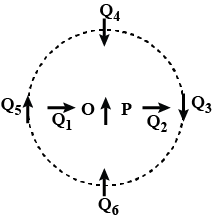
A wire is bent in the form of an equilateral triangle of side 100 cm and carries a current of 2A. It is placed in the magnetic field of induction 2.0 T directed perpendicular to the plane of the paper. The direction and magnitude of the magnetic force acting on each side of the triangle will be.
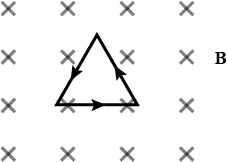
A particle of mass 'm' with charge 'q' moving with a uniform speed 'v' normal to a uniform magnetic field 'B', describe a circular path of radius 'r'. Derive expression for
(i) time period of revolution
(ii) kinetic energy of the particle
A magnetic field of $$8\hat{k}mT$$ exerts a force of $$(4.0\hat{i}+3.0\hat{j})\times 10^{-10}N$$ on a particle having a charging $$5\times 10^{-10}C$$ and going in the $$X-Y$$ plane. Find the velocity of the particles.
A proton moves along horizontal line towards observer.What will be the pattern of concentric circular field lines of magnetic field which produced due to its motion.
A bar magnet of magnetic moment $$1.5 J T^{1}$$ lies aligned with the direction of a uniform magnetic field of $$0.22 T$$.
What is the amount of work required by an external torque to turn the magnet so as to align its magnetic moment: (i) normal to the field direction, (ii) opposite to the field direction?
A straight, long wire carries a current of $$20\ A$$. Another wire carrying equal current is placed parallel to it. If the force acting on a length of $$10\ cm$$ of the second wire is $$2.0\times 10^{-5}N$$, what is the separation between them?
A coil of $$N$$ turns and radius $$R$$ carries a current $$I$$. It is unwound and rewound to make a square coil of side $$a$$ having same number of turns $$N$$. Keeping the current $$I$$ same find the ratio of the magnetic moments of the square coil and the circular coil.
A uniform magnetic field $$\bar{B}=B_{0}\bar{k}$$ is acting in the region where a circular current carrying loop is placed in x-y plane. Match the columns.
| column I | Column II | ||
| (A) | Equilibrium of loop | (p) | Along z-axis |
| (B) | torque of the loop | (q) | Zero |
| (C) | Magnetic moment of the loop | (r) | Stable |
| (D) | Potential energy of loop | (s) | None of the above |
State Ampere's circuital law. Use it to find magnetic field due to an infinity long thin current carrying wire.
A flat circular coil of 100 turns and radius 10 cm carries a current of 1 A. Then the magnetic dipole moment of the coil is_______ A.
A long wire with a small current element of length $$1cm$$ is placed at the origin and carries a current of $$10$$ A long the X-axis. Find out the magnitude and direction of the magnetic field due to the element on the Y-axis at a distance $$0.5$$m from it.
Magnetic force acting on the charged particle projected perpendicular to magnetic field is proportional to $$r^n$$, where r is radius of circular path. Find n.
'Biot Savart' law of magnetism is analogous to?
Derive an expression for magnitude of magnetic dipole moment of a revolving electron.
A circular coil of $$300 $$ turns and diameter $$14 cm$$ carries a current of $$15 A$$. Calculate the magnitude of the magnetic dipole moment associated with the coil.
Sometimes we show an idealised magnetic field which is uniform in a given region and falls to zero abruptly. One such field is represented in figure. Using Ampere's law over the path PQRS, show that such a field is not possible.
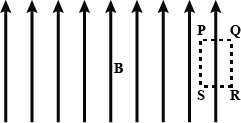
Two circular coils made of similar wires but of radii 20 and 40 cm are connected in parallel . Find the ratio of the magnetic field at their centers.
In Figure, two infinitely long wires carry equal currents $$i$$. Each follows a $$90^{\circ}$$ arc on the circumference of the same circle of radius $$R$$. Show that the magnetic field $$\vec{B}$$ at the center of the circle is the same as the field $$\vec{B}$$ a distance $$R$$ below an infinite straight wire carrying a current $$i$$ to the left.
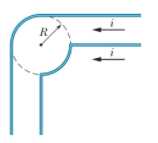
Suppose that $$\pm 4$$ are the limits to the values of $$m_l$$ for an electron in an atom. (a) How many different values of the electrons $$\mu_{orb,z}$$ are possible? (b) What is the greatest magnitude of those possible values? Next, if the atom is in a magnetic field of magnitude $$0.250$$ T, in the positive direction of the z-axis, what are (c) the maximum energy and (d) the minimum energy associated with those
possible values of $$\mu_{orb,z}$$?
With the help of neat diagram describe how you can generate induced current in the circuit.
A particle undergoes uniform circular motion of radius $$26.1 mm$$ in a uniform magnetic field. The magnetic force on the particle has a magnitude of $$1.60 \times10^{-17}N$$. What is the kinetic energy of the particle?
Figure shows, in cross section, two long parallel wires that are separated by distance $$d =18.6 cm$$. Each carries $$4.23 A$$, out of the page in wire 1 and into the page in wireIn unit-vector notation, what is the net magnetic field at point $$P$$ at distance $$R =34.2 cm$$, due to the two currents?

Draw the labelled diagram of a moving coil galvanometer. Prove that in a radial magnetic field, the deflection of the coil is directly proportional to the current flowing in the coil.
If an electron in an atom has an orbital angular
momentum with $$m=0$$, what are the components (a) $$L_{orb,z}$$, and
(b) $$\mu_{orb,z}$$? If the atom is in an external magnetic field that has a magnitude $$35\, mT$$, and is directed along the z-axis, what are (c) the
energy $$U_{orb}$$ associated with and (d) the energy $$U_{spin}$$ associated
with $$\vec \mu_s$$? If, instead, the electron has, what are (e) $$L_{orb,z}$$,
(f)$$\mu_{orb,z}$$, (g)$$U_{orb}$$, and (h)$$U_{spin}$$?
Answer the following question:
Write the expression for the force $$\vec F$$ acting on a particle of mass $$m$$ and charge $$q$$ moving with velocity $$\vec V$$ in a magnetic field $$\vec B$$ Under what conditions will it move in a circular path?
Answer the following question:
Draw the magnetic field lines due to two straight, long, parallel conductors carrying currents $$I_1$$ and $$I_2$$ in the same direction. Write an expression for the force acting per unit length on one conductor due to other. Is this force attractive or repulsive?
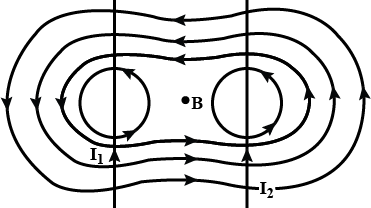
When a charged particle moving with velocity $$\vec{V}$$ is subjected to magnetic field $$\vec{B}$$ the force acting on it is non-zero. Would the particle gain any energy?
Answer the following question:
Show that the kinetic energy of the particle moving in magnetic field remains constant.
Describe the motion of a charged particle in a cyclotron if the frequency of the radio frequency (rf) field were doubled.
Show that the magnetic field $$B$$ at a point in between the plates of a parallel plate capacitor during charging is $$\cfrac { { \mu }_{ 0 }{ \varepsilon }_{ 0 }r }{ 2 } \cfrac { dE }{ dt } $$
A copper coil is connected to a galvanometer. What would happen if a bar magnet is
(i) pushed into the coil with its north pole entering first
(ii) held at rest inside the coil
(iii) pulled out again?
Name the scientist who discovered the relationship between electric current and magnetic field.
Two long wires carrying current $$I_{1}$$ and $$I_{2}$$ are arranged as shown in Fig. the one carrying current $$I_{1}$$ is along is the X-axis. the other carrying current $$I_{2}$$ is along a line parallel to the force exerted at $$o_{2}$$ because of the wire along the x-axis. Find the force exerted by the wire at $$O_2$$ along the x axis.
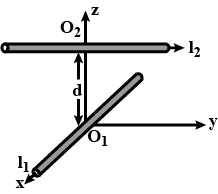
Use (i) the Ampere's law for $$H $$ and (ii) continuity of lines of $$ B$$, to conclude that inside a bar magnet, (a) lines of $$ H$$ run from the N-pole to S- pole, while (b) lines of $$ B $$ must run from the S-pole to N-pole.
(a) What kind of energy change takes place when a magnet is moved towards a coil having a galvanometer at its ends?
(b) Name the phenomenon
A bar magnet is placed in a uniform magnetic field such that its magnetic moment makes angle a with the direction of $$\overset{\rightarrow}{B}$$. Derive a expression for its potential energy.
Any charged particle enters in a uniform magnetic field at an angle $$\theta$$ (Where $${0}^{o}< \theta < {90}^{o}$$). How will be the path the particle? Calculate its pitch.
Two long parallel wires are $$4cm$$ apart. In them current $$I$$ and $$3I$$ are flowing in the same direction. Where would be the magnetic field generated by both should be zero?
Show that in a cyclotron inside the dee, the time taken to complete half-circular path is not dependent on the radius of the path.
Protons are accelerated in a cyclotron so that the maximum curvature radius of their trajectory is equal to $$r = 50\ cm$$. Find : (a) the kinetic energy of the protons when the acceleration is completed if the magnetic induction in the cyclotron is $$B = 1.0\ T$$;
(b) the minimum frequency of the cyclotron's oscillator at which the kinetic energy of the protons amounts to $$T = 20\ MeV$$ by the end of acceleration.
Find the interaction force of two coils with magnetic moments $$p_{1m} = 4.0\ mA . m^{2}$$ and $$p_{2m} = 6.0\ mA.m^{2}$$ and collinear axes if the separation between the coils is equal to $$l = 20\ cm$$ which exceeds considerably their linear dimensions.
Find the magnetic moment of a thin round loop with current if the radius of the loop is equal to $$R = 100\ mm$$ and the magnetic induction at its centre is equal to $$B = 6.0\ \mu T$$.
Up to what values of kinetic energy does the period of revolution of an electron and a proton in a uniform magnetic field exceed that at non-relativistic velocities by $$\eta = 1.0\%$$?
An electron starts moving in a uniform electric field of strength $$E = 10\ kV/cm$$. How soon after the start will the kinetic energy of the electron become equal to its rest energy?
Find the magnitude and direction of a force vector acting on a unit length of a thin wire, carrying a current $$I = 8.0\ A$$, at point $$O$$, if the wire is bent as shown in
(a) Fig. a, with curvature radius $$R = 10\ cm$$;
(b) Fig. b, the distance between the long parallel segments of the wire being equal to $$l = 20\ cm$$.
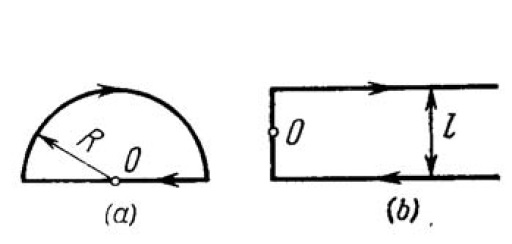
In a betatron the magnetic induction on an equilibrium orbit with radius $$r = 20\ cm$$ varies during a time interval $$\triangle t = 1.0\ ms$$ at parctically constant rate from zero to $$B = 0.40\ T$$. Find the energy acquired by the electron per revolution.
The Biot-Savart Law(3)
Calculate the magnitude of the magnetic field at a point $$25.0 \,cm$$ from a long, thin conductor carrying a current of $$2.00 \,A$$.
A current $$I = 5.0\ A$$ flows along a thin wire shaped as shown in Fig. The radius of a curved part of the wire is equal to $$R = 120\ mm$$, the angle $$2\varphi = 90^{\circ}$$. Find the magnetic induction of the field at the point $$O$$.
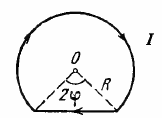
Two protons move parallel to each other with an equal velocity $$v=300\ \text{km/s}$$. The ratio of forces of magnetic and electrical interaction of the protons is given as $$x\times10^{-6}.$$ Find $$x$$
An $$\alpha-\text{particle}$$ is describing a circle of radius $$0.45\ \text{m}$$ in a field of magnetic induction of $$1.2\ \text{T}.$$ If its kinetic energy is $$14.3\times 10^{X} \in eV\}$$. The mass of $$\alpha-\text{particle}$$ is $$6.8\times 10^{-27}\ \text{kg}$$ and its charge is twice the charge of proton, i.e., $$3.2\times 10^{-19}\ \text{C}$$. Find out the value of X?
Calculate the magnetic moment of a thin wire with a current $$I=0.8\ A$$, wound tightly on a half a toroid. The diameter of the cross-section of the toroid is equal to $$d=5.0\ cm$$, the number of turns is $$N=500$$.

A current I flows in a rectangularly shaped wire whose center lies at $$(x_0, 0, 0)$$ and whose vertices are located at the point $$A(x_0+d, -a, -b), B(x_0-d, a, -b), C(x_0-d, a, +b)$$, and $$D(x_0+d, -a, +b)$$ respectively. Assume that a, b, d $$< < x_0$$. Find the magnitude of magnetic dipole moment vector of the rectangular wire frame in J/T. (Given: $$b=10 m, I=0.01 A, d=4m, a=3m$$.)
A charged particle passes through a region that could have electric field only or magnetic field only or both electric and magnetic fields or none of the fields. Match Column I with Column II
A pair of stationary and infinitely long bent wires is placed in the x-y plane as shown in figure. Each wire carries current of $$10A$$. Segments $$L$$ and $$M$$ are along the x-axis.Segments $$P$$ and $$Q$$ are parallel to the y-axis such that $$OS=OR=0.02m$$. Find the magnitude and direction of the magnetic induction at origin $$O$$ in the form of $$x\times 10^{-4}$$. What is x.
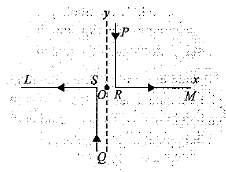
An elevator carrying a charge of $$0.5\ C$$ is moving down with a velocity of $$5\times { 10 }^{ 3 }\ m$$ $${ s }^{ -1 }$$. The elevator is $$4\ m$$ from the bottom and $$3\ m$$ horizontally form $$P$$ as shown in figure. What magnetic field (in $$\mu T$$) does it produce at point $$P$$?
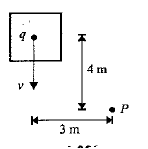
Two protons move parallel to each other with an equal velocity $$v=300km$$ $${s}^{-1}$$. Find the ratio of forces of magnetic and electric interaction of the protons. Give your answer after multiplying by $$10^6$$.
Challenge Problems(80)
A proton moving in the plane of the page has a kinetic energy of $$6.00 \,MeV$$. A magnetic field of magnitude $$B = 1.00 \,T$$ is directed into the page. The proton enters the magnetic field with its velocity vector at an angle $$\theta = 45.0^{o}$$ to the linear boundary of the field as shown in Figure.
(a) Find $$x$$, the distance from the point of entry to where the proton will leave the field.
(b) Determine $$\theta$$, the angle between the boundary and the proton's velocity vector as it leaves the field.
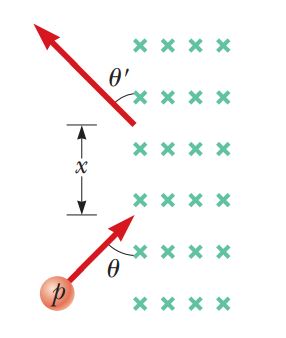
A wire loop carrying current is placed in the x-y plane as shown in figure. If a particle with charge $$+Q$$ and mass $$m$$ is placed at the center $$P$$ and given a velocity $$\vec { v } $$ along $$NP$$, If its instantaneous acceleration is given by $$\vec { a } ={ 10 }^{ -x }\cfrac { 2QvI }{ a } \left[ \sqrt { 3 } -\cfrac { \pi }{ 3 } \right] $$. Find x.

Three wires are carrying same constant current $$i$$ indifferent directions. Four loops enclosing the wires in different manners are shown in figure. The direction of $$d\vec { l } $$ is shown in figure.
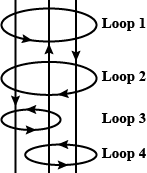
A wire carrying current $$i$$ has the configuration shown in the figure. Two semi-infinite straight sections, each tangent to the same circle, are connected by a circular arc, of angle $$\theta$$, along the circumference of the circle, with all sections lying in the same plane. What must $$\theta$$ (in rad) be in order for $$B$$ to be zero at the center of the circle?

Find the magnetic moment of the current carrying loop OABCO shown in figure.
Given that , i = 4.0 A, OA=20 cm and AB =10 cm.

A coil of radius $$R$$ carries current $${i}_{1}$$. Another concentric coil of radius $$r(r<<R)$$ carries current $${i}_{2}$$. Places of two coils are mutually perpendicular and both the coils are free to rotate about common diameter. If the maximum kinetic energy of smaller coil when both are released is $$\cfrac { { \mu }_{ 0 }{ i }_{ 1 }{ i }_{ 2 }\pi { r }^{ 2 }MR }{ X{ \left( { MR }^{ 2 }+{ mr }^{ 2 } \right) } } $$. Find X?Masses of coils are $$M$$ and $$m$$, respectively.
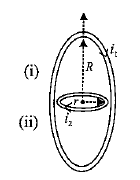
A conductor carries a constant current I along the closed path abcdefgha involving 8 of the 12 edges each of length l.Find the magnetic dipole moment of the closed path. The answer is $$M=xI{l}^{2}\hat{j}$$ then x is
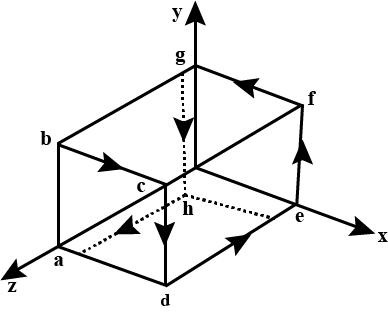
$$x=0,y=0,z=+0.500 m$$
Find $$x$$ such that $$x=100\times{F}_{2}$$
A bar magnet of magnetic moment $$2.0A-{m}^{2}$$ is free to rotate about a vertical axis through its centre. The magnet is released from rest from the east-west position. The kinetic energy of the magnet as it takes the north-south position is found to be $$\alpha\times {10}^{-8}J$$, where $$\alpha$$ and $$\beta$$ are the single digit integers. Then find the value of $$\alpha/ \beta$$. The horizontal component of the earth's magnetic field is $$B=25\mu T$$.Earth's magnetic field is from south to north.
A pair of point charges,$$q=+4.00\mu C$$ and $${q}^{'}=-1.50\mu C$$,are moving in a reference frame as shown in figure.At this instant, the magnitude of the magnetic field produced at the origin is 164$$\times10^{-x}$$. Find the value of x. (Take $$v=2.00\times {10}^{5}m/s$$ and $${v}^{'}=8.00\times {10}^{5}m/s$$.)
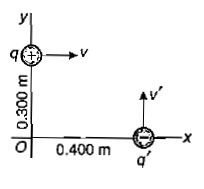
x=0.500 m,y=0.500m,z=0
A straight magnetised wire of magnetic moment '$$M$$' is bent as shown. Find resultant magnetic moment in each case.

An electron enters perpendicularly to a uniform magnetic field $$0.1N/amp-m$$ at a speed of $${ 10 }^{ 5 }m/s$$. Calculate the Lorentz force on the electron.
(a) Write using Biot - Savart Law, the expression for magnetic field $$\vec B$$ due to an element $$\vec {dl}$$ carrying current $$I$$ at a distance $$\vec r$$ from it in a vector form.
Hence derive the expression for the magnetic field due to a current carrying loop of radius $$R$$ at a point P distant $$x$$ from its centre along the axis of the loop.
(b) Explain how Biot - Savart law enables one to express the Ampere's circuital law in the integral form, viz.,
$$\vec B . \vec {dl} = \mu_o I$$
where $$I$$ is the total current passing through the surface.
Figure shows a long wire bent at the middle to form a right angle. Show that the magnitudes of the magnetic fields at the points $$Q$$ and $$R$$ are unequal and find these magnitudes. The wire $$w_{1}$$ and the circumference circle are coplanar and $$w_{2}$$ is perpendicular to plane of paper. Also find the ratio of field at $$Q$$ and $$R$$.

An electron is projected horizontally with a kinetic energy of $$10keV$$. A magnetic field of strength $$1.0\times {10}^{-7}T$$ exists in the vertically upward direction. (a) Will the electron deflect towards right or towards left of its motion ? (b) Calculate the sideways deflection of the electron in travelling through $$1m$$. Make appropriate approximations.
Two circular loops of radii R and r(R >> r) have same centre and carry currents I and i respectively. Find the maximum torque and maximum angular acceleration of smaller loop, if it is free to rotate about y axis where as the bigger loop is fixed. (Neglect the inductance of the system). The mass of the smaller loop is m.
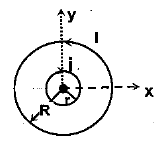
A long, straight wire carries a current $$i$$. Let $$B_{1}$$ be the magnetic field at a point $$P$$ at a distance $$d$$ from the wire. Consider a section of length $$l$$ of this wire such that the point $$P$$ lies on a perpendicular bisector of the section. Let $$B_{2}$$ be the magnetic field at this point due to this section only. Find the value of $$d/l$$ so that $$B_{2}$$ differs from $$B_{1}$$ by $$1\%$$.
A very long wire carrying a current $$I = 5.0\ A$$ is bent a right angles. Find the magnetic induction at a point lying on the perpendicular bisector to the wire, drawn through the point of bending, at a distance $$l = 35\ cm$$ from it.
What are the applications of Ampere's law ?
In the figure, two long straight wires at separation $$d =16.0\hspace{0.05cm} cm$$ carry currents $$i_{1}= 3.61\hspace{0.05cm} mA$$ and $$i_2 = 3.00i_{1}$$ out of the page. (a) Where on the x-axis is the net magnetic field equal to zero? (b) If the two currents are doubled, isthe zero-field point shifted toward wire 1, shifted toward wire 2 or unchanged?

The Biot-Savart Law(14)
One long wire carries current $$30.0 \,A$$ to the left along the x axis. A second long wire carries current $$50.0 \,A$$ to the right along the line $$(y = 0.280 \,m, z = 0)$$.
(a) Where in the plane of the two wires is the total magnetic field equal to zero?
(b) A particle with a charge of $$-2.00 \,\mu C$$ is moving with a velocity of $$150\hat{i} \,Mm/s$$ along the line $$(y = 0.100 \,m, z = 0)$$. Calculate the vector magnetic force acting on the particle.
(c) What If? A uniform electric field is applied to allow this particle to pass through this region undeflected. Calculate the required vector electric field.
In the figure, two long straight wires are perpendicular to the page and separated by distance $$d_{1}=0.75\hspace{0.05cm} cm$$. Wire $$1$$ carries $$6.5 A$$ into the page. What are the (a) magnitude and (b) direction(into or out of the page) of the current in wire $$2$$ if the net magnetic field due to the two currents is zero at point P located at distance $$d_{2}=1.50\hspace{0.05cm}cm$$ from wire $$2$$?
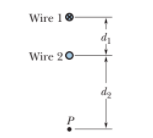
A 2.50 MeV electron moves perpendicularly to a magnetic field in a path with a $$3.0 \mathrm{cm}$$ radius of curvature. What is the magnetic field $$B ?$$ (See Problem 53 .)
An electron of kinetic energy $$1.20 keV$$ circles in a plane perpendicular to a uniform magnetic field. The orbit radius is $$25.0 cm$$. Find
(a) the electrons speed,
(b) the magnetic field magnitude,
(c) the circling frequency, and
(d) the period of the motion.
In the figure, part of a long insulated wire carrying current $$i=5.78\hspace{0.05cm}mA$$ is bent into a circular section of radius $$R=1.89\hspace{0.05cm}cm$$. In unit-vector notation, what is the magnetic field at the center of curvature $$C$$ if the circular sections (a) lies in the plane of the page as shown and (b) is perpendicular to the plane of the page after being rotated $$90^{\circ}$$ counterclockwise as indicated?
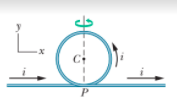
Figure shows two very long straight wires (in cross section) that each carry a current of $$4.00\hspace{0.05cm}A$$ directly out of the page. Distance $$d_{1}=6.00\hspace{0.05cm}m$$ and distance $$d_{2}=4.00\hspace{0.05cm}m$$. What is the magnitude of the net magnetic field at point P, which lies on the a perpendicular bisector to the wires?
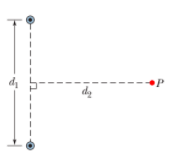
An electron is accelerated from rest through potential difference $$V$$ and then enters a region of uniform magnetic field, where it undergoes uniform circular motion. The figure gives the radius $$r$$ of that motion versus $$V^{1/2}$$. The vertical axis scale is set by $$r_{s}=3.0mm$$, and the horizontal axis scale is set by $$V_{s}^{1/2} = 40.0V^{1/2}$$. What is the magnitude of the magnetic field?
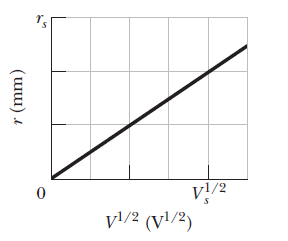
An alpha particle can be produced in certain radioactive decays of nuclei and consists of two protons and two neutrons. The particle has a charge of $$q = +2e$$ and a mass of $$4.00 u$$, where $$u$$ is the atomic mass unit, with $$1 u = 1.661 \times 10^{-27} kg$$. Suppose an alpha particle travels in a circular path of radius $$4.50 cm$$ in a uniform magnetic field with $$B = 1.20 T$$. Calculate
(a) its speed,
(b) its period of revolution,
(c) its kinetic energy, and
(d) the potential difference through which it would have to be accelerated to achieve this energy.
A certain particle is sent into a uniform magnetic field, with the particles velocity vector perpendicular to the direction of the field. The figure gives the period $$T$$ of the particles motion versus the $$inverse$$ of the field magnitude $$B$$. The vertical axis scale is set by $$T_{s}=40.0ns$$, and the horizontal axis scale is set by $$B_{s}^{-1}=5.0T^{-1}$$. What is the ratio $$m/q$$ of the particles mass to the magnitude of its charge?
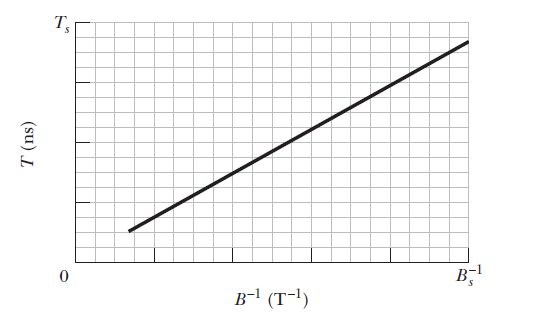
One long wire lies along an $$x$$ axis and carries a current of $$30 A$$ in the positive $$x$$ direction.A second long wire is perpendicular to the $$xy$$ plane, passes through the point $$(0, 4.0 m, 0)$$, and carries a current of $$40 A$$ in the positive $$z$$ direction.What is the magnitude of the resulting magnetic field at the point $$(0, 2.0\ m, 0)$$?
A proton traveling at $$23.0^{0}$$ with respect to the direction of a magnetic field of strength $$2.60 mT$$ experiences a magnetic force of $$6.50 \times 10^{-17} N$$. Calculate
(a) the protons speed and
(b) its kinetic energy in electron-volts.
In the figure, an electron accelerated from rest through potential difference $$V_{1}=1.00kV$$ enters the gap between two parallel plates having separation $$d=20.0mm$$ and potential difference $$V_{2}=100V$$. The lower plate is at the lower potential. Neglecting and assuming that the electron's velocity vector is perpendicular to the electric field vector between the plates. In unit-vector notation, what uniform magnetic field allows the electron to travel in a straight line in the gap?

A cyclotron with dee radius $$53.0 cm$$ is operated at an oscillator frequency of $$12.0 MHz$$ to accelerate protons.
(a) What magnitude $$B$$ of magnetic field is required to achieve resonance?
(b) At that field magnitude, what is the kinetic energy of a proton emerging from the cyclotron?
Figure shows, in cross section, two long parallel wires spaced by distance $$d 10.0 cm$$; each carries $$100 A$$, out of the page in wirePoint $$P$$ is on a perpendicular bisector of the line connecting the wires. In unit-vector notation, what is the net magnetic field at $$P$$ if the current in wire 2 is (a) out of the page and (b) into the page?
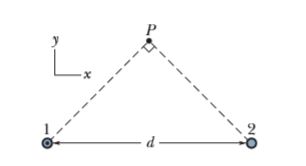
The Biot-Savart Law(17)
Determine the magnetic field (in terms of $$I, \,a$$, and $$d$$ ) at the origin due to the current loop in Figure. The loop extends to infinity above the figure.
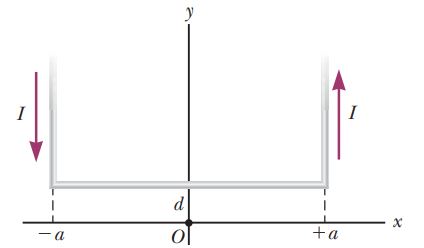
Two long straight thin wires with current lie against an
equally long plastic cylinder, at radius R=20.0 cm from the cylinder’s central axis. Figure (a) shows, in cross section, the cylinder
and wire 1 but not wire 2.With wire 2 fixed in place, wire 1 is moved around the cylinder, from angle $$\theta_{1}=0^{\circ}$$ to angle $$\theta_{1}=180^{\circ}$$, through the first and second quadrants of the $$xy$$ coordinate system. The net magnetic filed $$\vec{B}$$ at the center of the cylinder is measures as the function of $$\theta_{1}$$. Figure(b) gives the $$x$$ component $$B_{x}$$ of that field as a function of $$\theta_{1}$$ (the vertical scale is set by $$B_{xx}=6.0\hspace{0.05cm} \mu T)$$ and figure (c) gives the $$y$$ componenet of $$B_{y}$$ (the vertical scale is set by $$B_{yx}=4.0 \mu T$$ (a)At what angle $$\theta_{2}$$ is wire located? What are the (b) size and (c) direction (into or out of the page) of the current in wire 1 and the (d) size and (e) direction of the current in wire 2?
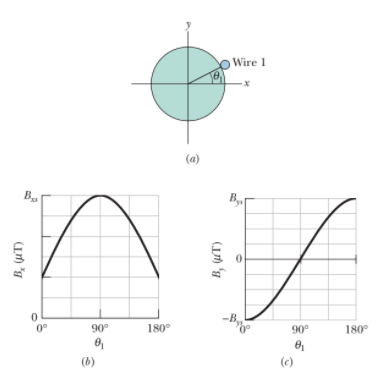
In a particular region, there is uniform current density of $$15\hspace{0.05cm}A/m^2$$ in positive $$z$$ direction. What is the value of $$\oint {\vec{B}\cdot d\vec{s}}$$ when that line integral is calculated along a closed path consisting of the three straight-line segments from $$(x,y,z)$$ coordinates $$(4d,0,0)$$ to $$(4d,3d,0)$$ to $$(0,0,0)$$ to $$(4d,0,0)$$ where d=20cm?
In the figure, a long circular pipe with outside radius R=2.6cm carries a (uniformly distributed) current i=8.00 mA into the page. A wire runs parallel to the pipe at a distance of 3.00R from center to center. Find the (a) magnitude and (b) direction (into or out of the page) of the current in the wire such that the net magnetic field at point P has the same magnitude as the net magnetic field at the center of the pipe but is in the opposite direction.
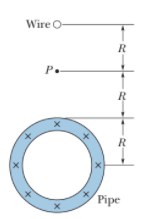
Two long wires lie in an $$xy$$ plane, and each carries a current in the positive direction of the $$x$$ axis. Wire 1 is at $$y =10.0\ cm$$ and carries $$6.00\ A$$; wire 2 is at $$y =5.00\ cm$$ and carries $$10.0\ A$$. (a) In unit-vector notation, what is the net magnetic field $$\vec{B}$$ at the origin? (b) At what value of $$y$$ does $$\vec{B}=0$$? (c) If the current in wire 1 is reversed, at what value of $$y$$ does $$\vec{B}=0$$?
In the figure, a charged particle moves into a region of uniform
magnetic field $$\vec{B}$$, goes through half a circle, and then exits that region. The particle is either a proton or an electron (you must decide which). It spends $$130 ns$$ in the region.
(a) What is the magnitude of $$\vec{B}$$?
(b) If the particle is sent back through the magnetic field (along the same initial path) but with $$2.00$$ times its previous kinetic energy, how much time does it spend in the field during this trip?
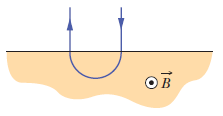
An electron follows a helical path in a uniform magnetic field of magnitude $$0.300 T$$. The pitch of the path is $$6.00 \mu m$$, and the magnitude of the magnetic force on the electron is $$2.00 \times10^{-15} N$$. What is the electrons speed?
A student makes a short electromagnet by winding 300 turns of wire around a wooden cylinder of diameter d=5cm. The coil is connected to a battery producing a current of 4.0 A in the wire. (a) What is the magnitude of the magnetic dipole moment of this device? (b) At what axial distance $$z>>d$$ will the magnetic field have the magnitude $$5.0\hspace{0.05cm} \mu T$$ (approximately one-tenth that ofEarth’s magnetic field)?
Three long wires all lie in an $$xy$$ plane parallel to the $$x$$ axis. They are spaced equally, $$10 cm$$ apart. The two outer wires each carry a current of $$5.0 A$$ in the positive $$x$$ direction. What is the magnitude of the force on a $$3.0 m$$ section of either of the outer wires if the current in the center wire is $$3.2 A$$ (a) in the positive $$x$$ direction and (b) in the negative $$x$$ direction?
Find an expression for the magnetic field at the centre of a circular coil of N- turns, radius $$r$$, carrying current $$I$$.
The figure shows a current loop ABCDEFA carrying a current $$i =
5.00 A$$. The sides of the loop are parallel to the coordinate axes shown, with $$AB = 20.0 cm$$,$$BC = 30.0 cm$$, and $$FA = 10.0 cm$$. In unit-vector notation, what is the magnetic dipole moment of this loop? (Hint: Imagine equal and opposite currents $$i$$ in the line segment $$AD$$; then treat the two rectangular loops ABCDA and ADEFA.)
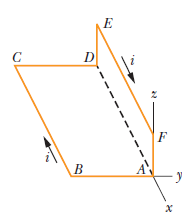
State and explain Biot-Savart law. Use it to derive an expression for the magnetic field produced at a point near long current carrying wire.
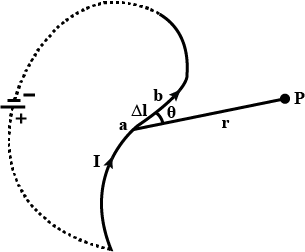
A uniform magnetic field $$\vec B$$ is set up along the positive $$x-$$axis. A particle of charge $$'q'$$ and mass $$'m'$$ moving with a velocity $$\vec V$$ enters the field at the origin in $$x-y$$ plane such that it has velocity components both along perpendicular to the magnetic field $$\vec B$$. Trace, giving reason, the trajectory followed by the particle.
Find out the expression for the distance moved by the particle along the magnetic field in one rotation.
A wire $$AB$$ is carrying a steady current of $$12\ A$$ and is lying on the table. Another wire $$CD$$ carrying $$5A$$ is held directly above $$AB$$ at a height of $$1\ mm$$. Find the mass per unit length of the wire $$CD$$ so that it remains suspended at its position when left free. Give the direction of the current flowing in $$CD$$ with respect to that in $$AB$$.
A beam of protons passes undeflected with a horizontal velocity $$v$$, through a region of electric and magnetic field, mutually perpendicular to each other and normal to the direction of the beam. If the magnitudes of the electric nad magnetic fields are $$50\ kV/m$$ and $$100\ mT$$ respectively; calculate the
Force with which it strikes a target on the screen. if the proton beam current is equal to $$0.80\ mA$$.
Figure shows an arrangement as a Helmholtz coil. It consists of two circular coaxial coils, each of 200 turns and radius R=25 cm, separated by a distance s=R. The two coils carry equal currents i=12.2 mA in the same direction. Find the magnitude of the net magnetic field at P, midway between the coils.
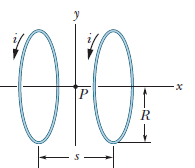
Figure a shows, in cross section, two wires that are straight, parallel, and very long. The ratio $$i_1/i_2$$ of the current carried by wire 1 to that carried by wire 2 is 1/Wire 1 is fixed in place. Wire 2 can be moved along the positive side of the x axis so as to change the magnetic energy
density $$u_B$$ set up by the two currents at the origin. Figure b gives $$u_B$$ as a function of the position x of wireThe curve has an symptote of $$u_b=1.96nJ/m^3$$ as $$x \rightarrow \infty $$, and the horizontal axis scale is set by $$x_s60.0cm$$.What is the value of (a) $$i_1$$ and (b) $$i_2$$?
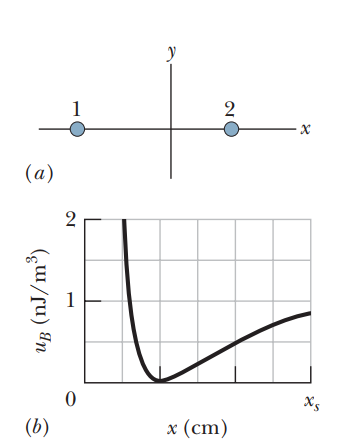
Write Ampere's Law. Obtain the expression for magnetic at the axis of long solenoid giving the necessary diagram.
Verify the Ampere's law for magnetic field of a point dipole of dipole moment $$ m = m\hat{k} $$. Take C as the closed curve running clockwise along (i) the z-aixs from $$ z=a> 0$$ to $$z= R $$; (ii) along the quarter circle of radius R and center at the origin, in the first quadrant of x-z plane; (iii) along the x-axis from x= R to x=a, and (iv) along the quarter circle of radius a and centre at the origin in the first quadrant of x-z plane.
Find the magnetic induction of the field at the point $$O$$ if a current-carrying wire has the shape shown in Fig. The radius of the curved part of the wire is $$R$$, the linear parts are assumed to be very long.

A conducting wire $$XY$$ of mass $$m$$ and negligible resistance slides smoothly on two parallel conducting wires as shown in Fig. The closed circuit has a resistance $$R$$ due to $$AC. AB$$ and $$C$$ are perfect conductors. There is a magnetic field $$B = B(t)\hat {k}$$.
If $$B$$ is independent of time, obtain $$v(t)$$, assuming $$v(0) = u_{0}$$, show that the decrease in kinetic energy of $$XY$$ equals the heat lost in $$R$$.
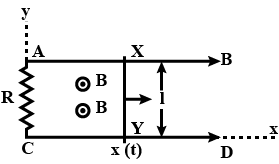
In a cyclotron, protons are to be accelerated. The radius of its D is $$60 \,cm.$$ and its oscillator frequency is $$10 \,MHz.$$ What will be the kinetic energy of the proton thus accelerated ?
(Proton mass $$= 1.67 \times 10^{-27} kg, e = 1.60 \times 10^{-19}C, eV = 1.6 \times 10^{-19}J$$)
The magnitude $$F$$ of the force between two straight parallel current carrying conductors kept at a distance $$d$$ apart in air is given by
$$F=\dfrac {\mu_0 I_1 I_2}{2\pi d} $$
Where $$I_1$$ and $$I_2$$ are the currents flowing through the two wires.
Use this expression, and the sign convention that the:
Force of attraction is assigned a negative sign and force of repulsion is assigned a positive sign.'
Draw graphs showing dependence of $$F$$ on
$$I_1 I_2$$ when $$d$$ is kept constant.
A small cylindrical magnet $$M$$ (Fig.) is placed in the centre of a thin coil of radius $$a$$ consisting of $$N$$ turns. The coil is connected to a ballistic galvanometer. The active resistance of the whole circuit is equal to $$R$$. Find the magnetic moment of the magnet if its removal from the coil results in a charge $$q$$ flowing through the galvanometer.
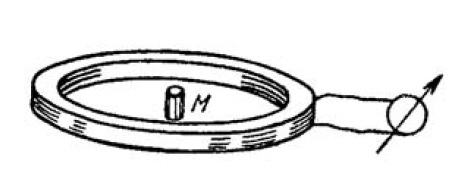
The magnetic induction in a betatron on an equilibrium orbit of radius $$r$$ varies during the acceleration time at practically constant rate from zero to $$B$$. Assuming the initial velocity of the electron to be equal to zero, find:
(a) the energy acquired by the electron during the acceleration time;
(b) the corresponding distance covered by the electron if the acceleration time is equal to $$\triangle t$$.
Analysis Model: Particle in a Field (Magnetic)(1)
At the equator, near the surface of the Earth, the magnetic field is approximately $$50.0 \mu T$$ northward, and the electric field is about $$100 \,N/C$$ downward in fair weather. Find the gravitational, electric, and magnetic forces on an electron in this environment, assuming that the electron has an instantaneous velocity of $$6.00 \times 106 \,m/s$$ directed to the east.
Experiment Deflection of the galvanometer needle increases decreases Number of turns increased Strong magnet is used Magnet/solenoid moves with grater speed
Using magnet of high strength, and increasing the number of turns in the solenoid, the experiment is repeated. On the basis of experiment is repeated. On the basis of the experiments complete the table (3.2).
(i) Why did the galvanometer needle deflect in the experiment ?
(ii) Which were the instances in which there was a flow of current through the solenoid ?
(iii) Which were the instances in which the current increased ?
| Experiment | Deflection of the galvanometer needle | |
| increases | decreases | |
| Number of turns increased | ||
| Strong magnet is used | ||
| Magnet/solenoid moves with grater speed | ||
Analysis Model: Particle in a Field (Magnetic)(9)
A proton travels with a speed of $$5.02 \times 10^6 \,m/s$$ in a direction that makes an angle of $$60.0^{o}$$ with the direction of a magnetic field of magnitude $$0.180 \,T$$ in the positive x direction. What are the magnitudes of
(a) the magnetic force on the proton and
(b) the protons acceleration?
Challenge Problems(78)
Protons having a kinetic energy of $$5.00 \,MeV (1 \,eV = 1.60 \times 10^{-19} \,J)$$ are moving in the positive x direction and enter a magnetic field $$\overrightarrow{B} = 0.050 0\hat{k} \,T$$ directed out of the plane of the page and extending from $$x = 0$$ to $$x = 1.00 \,m$$ as shown in Figure.
(a) Ignoring relativistic effects, find the angle a between the initial velocity vector of the proton beam and the velocity vector after the beam emerges from the field.
(b) Calculate the y component of the protons' momenta as they leave the magnetic field.
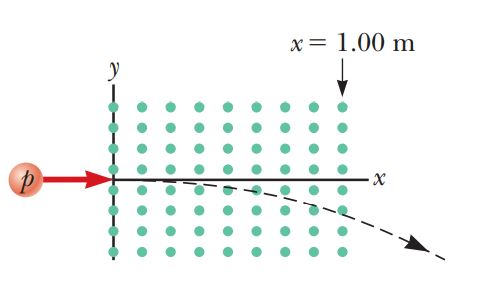
The Biot-Savart Law(10)
An infinitely long wire carrying a current $$I$$ is bent at a right angle as shown in Figure. Determine the magnetic field at point $$P$$, located a distance $$x$$ from the corner of the wire.
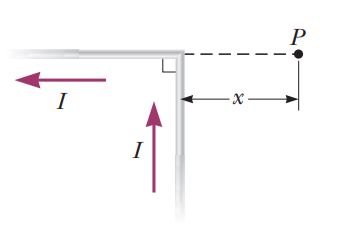
The Biot-Savart Law(13)
A current path shaped as shown in Figure produces a magnetic field at $$P$$, the center of the arc. If the arc subtends an angle of $$\theta = 30.0^{0}$$ and the radius of the arc is $$0.600 \,m$$, what are the magnitude and direction of the field produced at $$P$$ if the current is $$3.00 \,A$$?
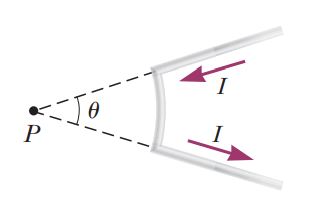
The Biot-Savart Law(8)
A conductor consists of a circular loop of radius $$R$$ and two long, straight sections as shown in Figure. The wire lies in the plane of the paper and carries a current $$I$$.
(a) What is the direction of the magnetic field at the center of the loop?
(b) Find an expression for the magnitude of the magnetic field at the center of the loop.
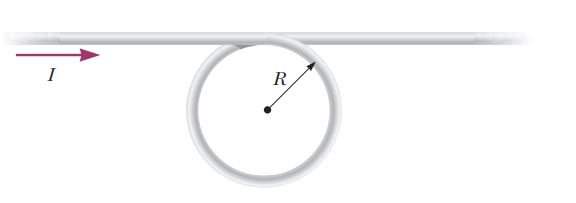
Conceptual Questions
Explain why two parallel wires carrying currents in opposite directions repel each other.
The Biot-Savart Law(5)
(a) A conducting loop in the shape of a square of edge length $$l = 0.400 \,m$$ carries a current $$I = 10.0 \,A$$ as shown on Figure. Calculate the magnitude and direction of the magnetic field at the center of the square.
(b) What If? If this conductor is reshaped to form a circular loop and carries the same current, what is the value of the magnetic field at the center?
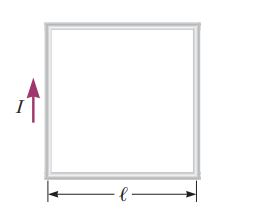
The Biot-Savart Law(8)
A long, straight wire carries a current $$I$$. A right-angle bend is made in the middle of the wire. The bend forms an arc of a circle of radius $$r$$ as shown in Figure. Determine the magnetic field at point $$P$$, the center of the arc.
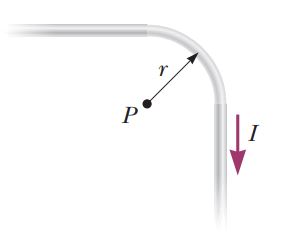
The Biot-Savart Law(6)
In Niels Bohr's 1913 model of the hydrogen atom, an electron circles the proton at a distance of $$5.29 \times 10^{-11} \,m$$ with a speed of $$2.19 \times 10^6 \,m/s$$. Compute the magnitude of the magnetic field this motion produces at the location of the proton.
Conceptual Questions
Compare Ampres law with the BiotSavart law. Which is more generally useful for calculating $$\overrightarrow{B}$$ for a current carrying conductor?
(a) Using Biot-Savarts law, derive an expression for the magnetic field at the centre of a circular coil of radius $$R$$, number of turns $$N$$, carrying current $$i$$.
(b) Two small identical circular coils marked 1, 2 carry equal currents and are placed with their geometric axes perpendicular to each other as shown in the figure. Derive an expression for the resultant magnetic field at $$O$$.
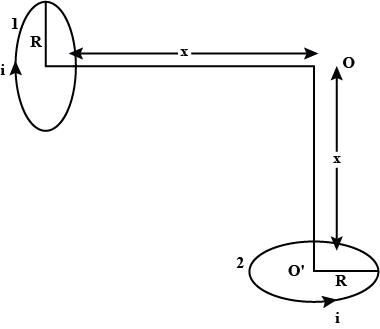
Class 12 Medical Physics Extra Questions
- Alternating Current Extra Questions
- Atoms Extra Questions
- Current Electricity Extra Questions
- Dual Nature Of Radiation And Matter Extra Questions
- Electric Charges And Fields Extra Questions
- Electromagnetic Induction Extra Questions
- Electromagnetic Waves Extra Questions
- Electrostatic Potential And Capacitance Extra Questions
- Magnetism And Matter Extra Questions
- Moving Charges And Magnetism Extra Questions
- Nuclei Extra Questions
- Ray Optics And Optical Instruments Extra Questions
- Semiconductor Electronics: Materials, Devices And Simple Circuits Extra Questions
- Wave Optics Extra Questions
